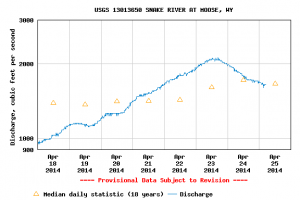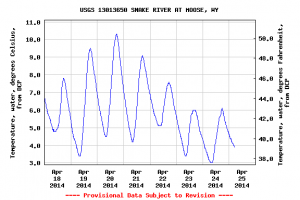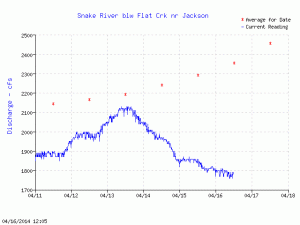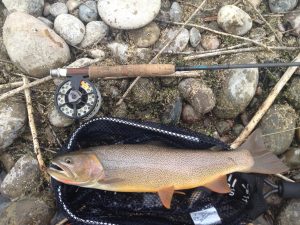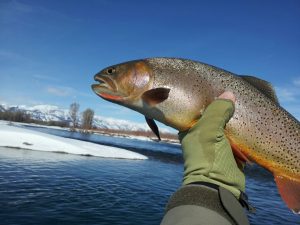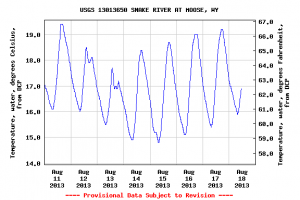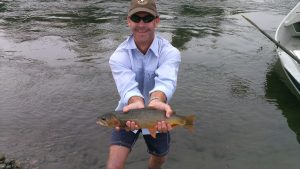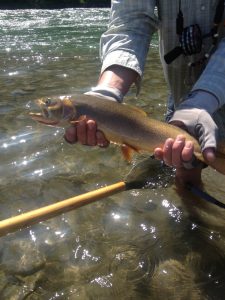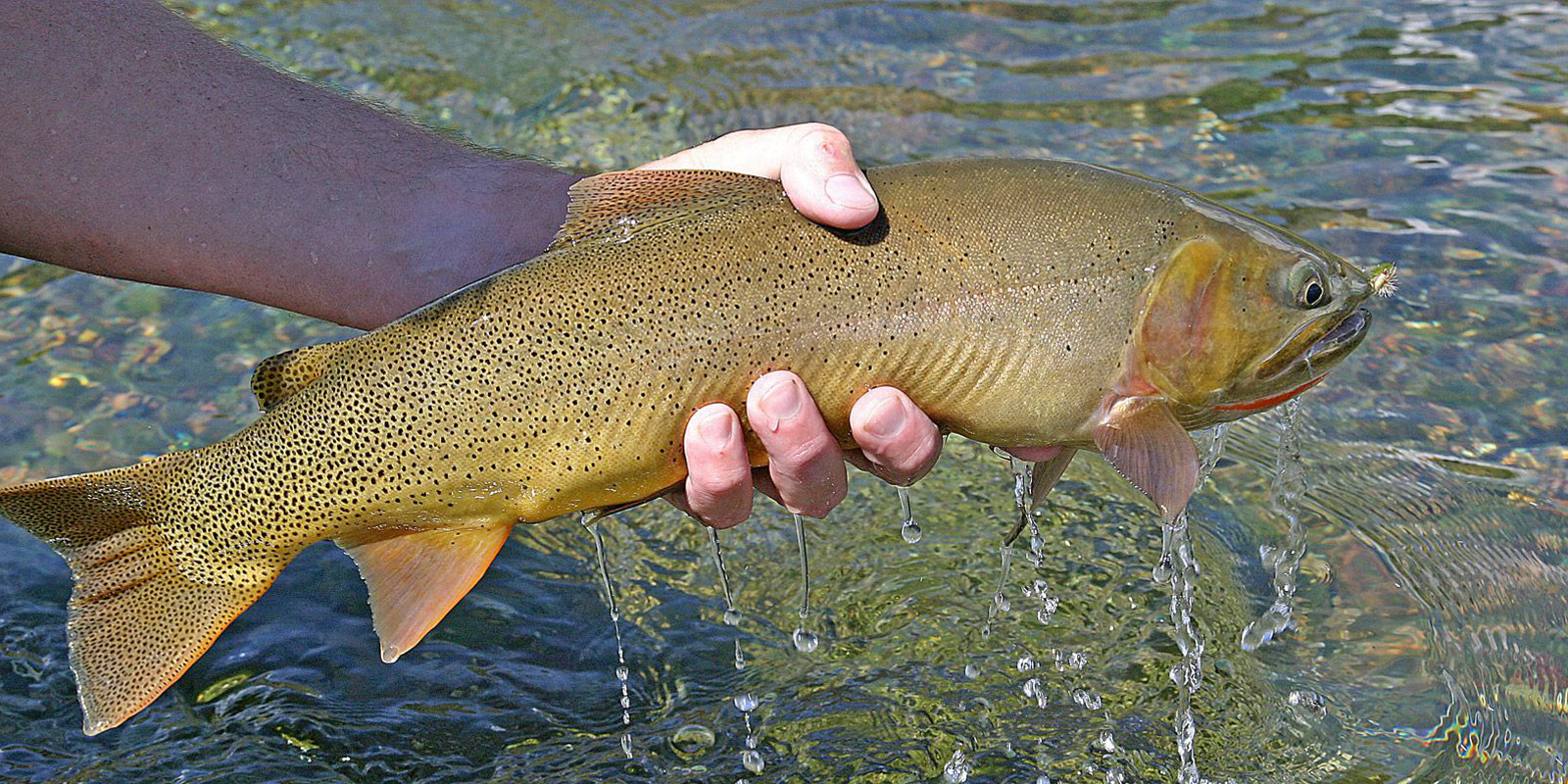
SNAKE RIVER FISHING REPORTS
Snake River Fishing Report
Please call or text us at 307-413-0669 or email: [email protected] for the latest update report. We’re now into the busy part of our season and still have some prime spots available to book so give us a call. Thank you very much! Tight Lines!
Snake River Jackson Hole Wyoming Fishing Guides
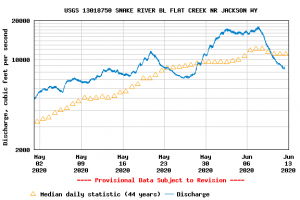
Current Snake River Flows
Flows are rolling now, so it’ll take some time for the fish to settled in. To book your summer trips please email or call us: [email protected] or 307-413-0669. We ready, willing and available!
Snake River Fishing Report
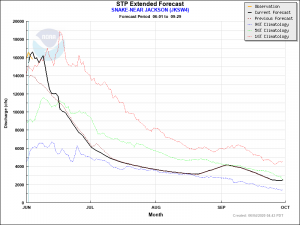
Current Snake River Flows
Based on all of this info/data we’re gonna shoot for early July to start guiding on the Snake River; Subject to change of course.
(Wednesday, June 3, 2020)
Subject: 2020 Upper Snake River Operations Update
Purpose: The purpose of these Updates is to provide information regarding Reclamation’s operations and basin conditions as the season progresses. The operations outlined in this update are based on the best data available at the time and are subject to change as new information becomes available. For additional information and resources, please visit our website at: https://www.usbr.gov/pn/hydromet/uppersnake/.
*Highlights
*Jackson Lake: Discharge will be increased overnight by 750 cubic feet per second (cfs) to a flow rate of approximately 5,500 cfs.
*Palisades Reservoir: Discharge will be increased overnight by 1,250 cubic feet per second (cfs) to a flow rate of approximately 17,500 cfs.
*Lower System:The combination of increased releases from Palisades Reservoir, local precipitation, and potential fluctuations in irrigation are likely to result in water that is in excess of reservoir storage capacity being released below Milner dam.
Operations Summary
*Jackson Lake: Jackson Lake’s discharge is being increased to 5,500 cfs to manage the reservoir’s rate of fill, which has been as high as 16,000 acre-feet per day during the last week. Additional increases over the next 7-14 days may be needed to maintain acceptable reservoir levels.
Snake River Fishing Report
5.3.2020
Flows near Jackson: 6100 CFS
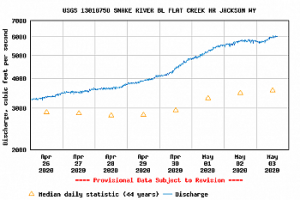
Flows Near Jackson
The Snake River Fishing Report is RUNOFF has commenced and it’ll be high and muddy for awhile looking at the forecasted temperatures. We are looking forward to a great summer season and hope to hear from the Governor later this week about when they will relax the 14 day quarantine and re-instate the 1 and 5 day out of state fishing licenses. As soon as we get the green light on these orders we will make a post and get you scheduled for some much needed r and r on the water! By looking at the data on the graph below we’re thinking the Snake may potentially eclear around the 4th of July or soon thereafter. To book your trip of get the latest updated information please call 307-413-0669 or email; [email protected]. We will be adhering to the Teton County health department for their mandatory. protocols. We suggest you bring your own personal masks, gloves and hand sanitizer along. After your reservation is made please call us several days prior to your departure so we can check in please. For the latest please click on: https://www.jhcovid.com/news-orders.

Snake River Projected Flows
Stay safe, see you all soon and safe travels!!!
Snake River Fishing Report
4.15.2020
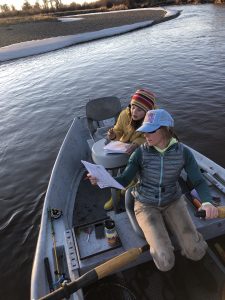
Remote Learning
Flows at Moose: 1510 CFS
Flows near Jackson: 2100 CFS
Reel Deal Anglers’ Snake River Fishing Report: Fishing conditions on the Snake River in Jackson Hole Wyoming continue to improve as Spring settles in and the weather warms. The best window for dry fly fishing has been between 10:00 a.m. and 4:00 p.m., especially on days when the temperature climbs into the forties or above. Midges, Capnia Stones and BWOs can be encountered on any given day. Think Griffith’s gnats and Film Critics! Fish have been holding and feeding in a wide variety of water types, including riffles, pools, flats, eddies and seams. Double nymph rigs have been producing with the most consistency throughout the day, but don’t hesitate to chuck a streamer with a varied retrieve at any point. Stay safe and please respect social distancing guidelines, especially at the boat ramps. For further details about the upcoming season please call 307-413-0669 or email; [email protected]. Enjoy your time with your family!
NOTE: Currently we are NOT guiding spring trips due to our collective choice, as a company, to help avoid any unnecessary contact with others to help expedite the eradication of the Covid-19.
Snake River Jackson Hole Wyoming Update
8.22.2019
Today’s Snake River Jackson Hole Wyoming Update comes from the Bureau of Reclamation today. Jackson Lake should end up with about 75-80% full, which means we are looking fantastic for next years season!
Reservoir Storage (Acre-Feet):
|
Reservoir Name |
Current Storage |
% Full |
% of 81-10 Avg |
2018 |
|
Jackson Lake |
732,182 AF |
86% |
129% |
758,730 AF |
|
Palisades |
952,473 AF |
79% |
137% |
855,254 AF |
|
Island Park |
110,062 AF |
81% |
154% |
102,235 AF |
|
Ririe |
76,902 AF |
96% |
125% |
75,523 AF |
|
American Falls |
578,634 AF |
35% |
86% |
637,894 AF |
|
Total System |
2,550,939 AF |
63% |
117% |
2,531,628 AF |
Snake River Jackson Hole Wyoming Fishing Report

Snake River Happiness
8.22.2019
Flows at Moose: 3380 CFs
Flows South of JH: 3640 CFS
The Snake River Jackson Hole Wyoming Fishing Report is STONEFLY MANIA!!!! The fish are keyed in on the stones and do yourself a favor and get out there! The flows are ideal and so are the water temps. Looking at the forecast ahead the weather looks to be nothing short of ideal. There are still caddis in the afternoon and evening and on the hot bright days the hoppers are a go to, for sure. We’ve also been seeing a lot of action on ant patterns; both carpenter and cinnamon respectively. To keep the action going throughout the day don’t hesitate adding a dropper below the hopper or stonefly.
To book your fall fishing trip please email; [email protected] or call/text 307-413-0669. Thank you and Fish On!
Snake River Jackson Wyoming Fishing Report

Kids’ Smiles are the BEST!!!
8.8.2019
Flows at Moose: 3470 CFS
Flows Below JH; 4060 CFS
The latest Snake River Jackson Wyoming Fishing Report is the action has been getting better every day and the Snake River is in fine shape and setting up for a September to Remember! Look for Caddis in the mornings and PMD’s in the afternoons. The best action is found either tight to the banks, structure or in the riffles and seams. There’s been a few reports of the Claassenia stones around so foam imitations are working well. On the hot and bright sunny afternoons get your hopper tied on and use a dropper to keep the bite rolling. We are seeing a lot of interest in the power ants in both black and cinnamon bodies.
To book your trip please call 307-413-0669 or email; [email protected]. Tight Lines and get out there!!!
Snake River Jackson Hole Wyoming Fishing Report
Given this report on the Jackson dam flows being reduced today, the tributairy flows slowing dow, the Snake should be finally set into the summer season flows etc in the next few days. It’s fishing ok right now and there’s a ton of bugs out, which is all great news! To book your trip please call 307-413-0669 or email; [email protected].
Hello,
Below is an update on the Bureau of Reclamation’s water operations in the upper Snake River watershed.
(Monday July 8, 2019)
Subject: 2019 Upper Snake River Operations Update
Purpose: The purpose of these Operation Updates is to provide information regarding Reclamation’s operations as the season progresses. The operations outlined in this update are based on the best data available at the time and are subject to change as new information becomes available. For additional information and resources, please visit our website at: https://www.usbr.gov/pn/hydromet/uppersnake/ .
Jackson Lake Dam
· Current Discharge = 3,100 cfs.
· Today (7/8) discharge will decrease to approximately 2,300 cfs.
Summary
The Upper Snake reservoir system is currently 91% full (3,661,459 acre-feet out of 4,045,695 acre-feet). From June 30th to July 6th unregulated inflow above Heise, ID, measured 109% of average. System inflows are receding at a moderate pace and outflows from the reservoirs in the system will be governed by natural flow and storage flow deliveries from this week until the late fall months when outflows will be adjusted down to winter flows in the October timeframe.
Jackson Lake’s discharge is being decreased today to the target summer flow from Jackson Lake Dam. The flow may be adjusted slightly during the summer months to target reaching a storage of approximately 577,000 acre-feet by October 1st.
Reservoir levels, reservoir discharge and river flows can be monitored on the USBR Hydromet page here: https://www.usbr.gov/pn/hydromet/
The Upper Snake “teacup” diagram which provides a graphical overview of system conditions can be accessed here: https://www.usbr.gov/pn/hydromet/burtea.html
Snake River Fishing Report

Snake River Cuttie
6.29.2019
Flows below Jackson; 7500cfs
The Snake River Fishing Report from Jackson Hole Wyoming today is there’s bugs galore out there and the fishing yield is increasing every day! There’s caddis, yellow sallies and stones all over the place. The fish seem mostly interested in the caddis in the slower water below the riffles, eddies and side channels. Look for the water flows to increase as the temps do in the afternoons. There’s plenty of snow left to melt above 10.000 feet so the season is shaping up to be awesome! Be careful out on the water b/c there’s new strainers throughout the entire corridor so know your route before launching! To book your trip or to get the latest, please call us @ 307-413-0669 or email; [email protected]. Fish On!
Snake River Jackson Hole Wyoming Fishing Report
6.25.2019
CRAZY is what this runoff scenario has been thus far! The flows have dropped by approx 50% in the past week with the cold temps. We’re still not sure if there’s going to be another snowmelt surge but we’re guiding trips for now and please call us @ 307-413-0669 or email; [email protected] to check in on the latest or to book your trip. https://www.reeldealanglers.com/reservations/
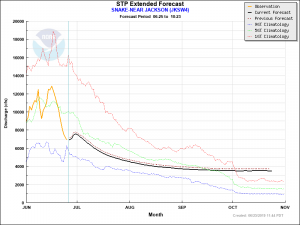
CRAZY SNAKE RIVER FLOWS
Snake River Fishing Report Jackson Hole Wyoming
6.13.2019
With this info we’re thinking we’ll be guiding on the Snake River around the 4th of July. To book your trip, get the latest or say hello please call us @ 307-413-0669 or email; [email protected].

The latest Snake River Prediction
Snake River Jackson Hole Wyoming Fishing Report
6/10/2019
Hello,
below is an update on the Bureau of Reclamation’s water operations in the upper Snake River watershed.
(Monday June 10, 2019)
Subject: 2019 Upper Snake River Operations Update
Purpose: The purpose of these Operation Updates is to provide information regarding Reclamation’s operations as the season progresses. The operations outlined in this update are based on the best data available at the time and are subject to change as new information becomes available. For additional information and resources, please visit our website at: https://www.usbr.gov/pn/hydromet/uppersnake/ .
Upcoming discharge changes
Jackson Lake Dam
· Current discharge = 2,000 cfs.
· Monday morning (6/10) discharge will increase to 3,000 cfs.
· Monday afternoon (6/10) discharge will increase to 4,000 cfs.
Palisades Dam
· Current discharge = 9,000 cfs.
· Monday afternoon (6/10) at 1 pm discharge will increase to 10,500 cfs.
· Monday afternoon (6/10) at 3 pm discharge will increase to 12,000 cfs.
Summary
The Upper Snake reservoir system is currently 93% full (3,746,699 acre-feet out of 4,045,695 acre-feet). Flow changes from Jackson Lake and Palisades Reservoir are being made today to continue to track along flood control requirements. Additional discharge changes could be made in the coming days at Jackson Lake and Palisades Reservoir and will depend on inflow forecasts and storage in the reservoirs. The reservoirs are targeted to fill in late June.
Reservoir levels, reservoir discharge and river flows can be monitored on the USBR Hydromet page here: https://www.usbr.gov/pn/hydromet/
The Upper Snake “teacup” diagram which provides a graphical overview of system conditions can be accessed here: https://www.usbr.gov/pn/hydromet/burtea.html
Thanks,
Brian
—
Brian Stevens
Water Operations Manager
Upper Snake Field Office
Middle Snake Field Office
Bureau of Reclamation
470 22nd St.
Heyburn, ID 83336
Snake River Jackson Hole WY Fishing Report
Here’s the latest Snake River Jackson Hole WY Fishing Report;
Hello,
below is an update on the Bureau of Reclamation’s water operations in the upper Snake River watershed.
(Friday June 7, 2019)
Subject: 2019 Upper Snake River Operations Update
Purpose: The purpose of these Operation Updates is to provide information regarding Reclamation’s operations as the season progresses. The operations outlined in this update are based on the best data available at the time and are subject to change as new information becomes available. For additional information and resources, please visit our website at: https://www.usbr.gov/pn/hydromet/uppersnake/ .
Summary
The Upper Snake reservoir system is currently 90% full (3,647,015 acre-feet out of 4,045,695 acre-feet).
Warm temperatures over the last few days accompanied by precipitation today in the Snake River headwaters are leading to increased inflow over the weekend. Inflows are forecasted to recede through the first part of next week with some precipitation arriving late next week potentially increasing inflows somewhat next weekend. Inflow forecasts and flood control requirements will determine what flow changes at Jackson Lake and Palisades Reservoir are made next week. Jackson Lake and Palisades Reservoir continue to track their flood control requirements with the target of refilling the reservoirs in late June. American Falls Reservoir is currently drafting by approximately 2,700 cfs. Potential increases from Palisades Dam next week are not likely to keep American Falls Reservoir full as irrigation demand continues to increase, therefore the likelihood of spilling excess water past Milner Dam in the short term is very low.
Jackson Lake’s discharge is currently 2,000 cfs. Discharge may increase next week and will depend on inflow forecasts and flood control targets.
Hello,
below is an update on the Bureau of Reclamation’s water operations in the upper Snake River watershed.
(Friday June 7, 2019)
Subject: 2019 Upper Snake River Operations Update
Purpose: The purpose of these Operation Updates is to provide information regarding Reclamation’s operations as the season progresses. The operations outlined in this update are based on the best data available at the time and are subject to change as new information becomes available. For additional information and resources, please visit our website at: https://www.usbr.gov/pn/hydromet/uppersnake/ .
Summary
The Upper Snake reservoir system is currently 90% full (3,647,015 acre-feet out of 4,045,695 acre-feet).
Warm temperatures over the last few days accompanied by precipitation today in the Snake River headwaters are leading to increased inflow over the weekend. Inflows are forecasted to recede through the first part of next week with some precipitation arriving late next week potentially increasing inflows somewhat next weekend. Inflow forecasts and flood control requirements will determine what flow changes at Jackson Lake and Palisades Reservoir are made next week. Jackson Lake and Palisades Reservoir continue to track their flood control requirements with the target of refilling the reservoirs in late June. American Falls Reservoir is currently drafting by approximately 2,700 cfs. Potential increases from Palisades Dam next week are not likely to keep American Falls Reservoir full as irrigation demand continues to increase, therefore the likelihood of spilling excess water past Milner Dam in the short term is very low.
Jackson Lake’s discharge is currently 2,000 cfs. Discharge may increase next week and will depend on inflow forecasts and flood control targets.
(Friday May 31, 2019)
Subject: 2019 Upper Snake River Operations Update
Purpose: The purpose of these Operation Updates is to provide information regarding Reclamation’s operations as the season progresses. The operations outlined in this update are based on the best data available at the time and are subject to change as new information becomes available. For additional information and resources, please visit our website at: https://www.usbr.gov/pn/hydromet/uppersnake/ .
Jackson Lake Dam
· Current Discharge = 3,100 cfs.
· Monday morning (6/3) discharge will decrease to 2,000 cfs.
Summary
The Upper Snake reservoir system is currently 86% full (3,490,023 acre-feet out of 4,045,695 acre-feet).
Jackson Lake and Palisades Reservoir will be in flood control operations until late June. The other reservoirs in the system are very close to full and will be passing inflow by early next week.
Jackson Lake’s discharge is currently 3,150 cfs. Discharge will decrease Monday morning, 6/3, to 2,000 cfs to continue to track along flood control requirements.
Snake River Jackson Hole Wyoming
5/31/2019
If this flow prediction is accurate then we’re planning to start guiding on the Snake River Jackson Hole Wyoming around the 4th of July! To get the latest and/or book your trip, please call us @ 307-413-0669 or email; [email protected]. Fish On!!

Snake River Flow Prediction
Hello,
Below is an update on the Bureau of Reclamation’s water operations in the upper Snake River watershed.
Thanks,
Brian
(Friday May 17, 2019)
Subject: 2019 Upper Snake River Operations Update
Purpose: The purpose of these Operation Updates is to provide information regarding Reclamation’s operations as the season progresses. The operations outlined in this update are based on the best data available at the time and are subject to change as new information becomes available. For additional information and resources, please visit our website at: https://www.usbr.gov/pn/hydromet/uppersnake/ .
Summary
The Upper Snake reservoir system is currently 80% full (3,229,705 acre-feet out of 4,045,695 acre-feet).
The precipitation outlook for the next week looks moderate with widespread one to two inches forecasted over the next 7 days. Temperatures are forecast to remain cool over the next week. The first half of May was drier and cooler than normal, but due to the expected precipitation, runoff forecasts were not revised from the May 1 values.
Jackson Lake’s discharge was increased from 3,000 cfs to 4,500 cfs this week as storage content continues to track near flood control requirements.
|
Facility |
% Full |
Storage (acre-feet) |
May – July Runoff Forecast % of Normal |
Yesterday’s Inflow (cfs) |
Estimated Outflow (cfs) |
Next anticipated discharge change |
|
Jackson Lake |
79% |
671,402 |
112% |
7,900 |
4,500 |
Not scheduled |
|
Palisades |
55% |
656,331 |
107% |
21,300 |
13,000 |
Not scheduled |
|
Ririe |
97% |
78,248 |
110% |
370 |
150 |
Not scheduled |
|
Island Park |
88% |
118,398 |
109% |
1,390 |
750 |
Decrease to 700 cfs tomorrow (5/18) morning |
|
Grassy Lake |
94% |
14,336 |
– |
53 |
0 |
Not scheduled |
|
American Falls |
96% |
1,600,000 |
– |
9,700 |
8,500 |
Not scheduled |
|
Minidoka |
97% |
92,624 |
– |
9,700 |
6,760 |
Not scheduled |
|
Milner |
0.5 feet below full |
– |
7,300 |
0 *River QD |
Not scheduled |
|
|
Little Wood |
94% |
28,072 |
118% |
520 |
320 |
Not scheduled |
Snake River Wyoming Fishing Report
5.11.19 Snake River Wyoming Fishing Report. To get the latest please contact us @ 307-413-0669 or email; [email protected]. FISH ON!!!
Hello,
below is an update on the Bureau of Reclamation’s water operations in the upper Snake River watershed.
Thanks,
Brian
(Friday May 10, 2019)
Subject: 2019 Upper Snake River Operations Update
Purpose: The purpose of these Operation Updates is to provide information regarding Reclamation’s operations as the season progresses. The operations outlined in this update are based on the best data available at the time and are subject to change as new information becomes available. For additional information and resources, please visit our website at: https://www.usbr.gov/pn/hydromet/uppersnake/ .
Upcoming discharge changes
Milner Dam – a small amount of flow will be going by Milner Dam until Tuesday (5/14), on which date discharge at Milner Dam will go to 0 cfs. Decreased flow into the Milner pool will be stored in Lake Walcott in the short term.
· Current discharge today = 350 cfs.
· Tuesday (5/14) discharge will go to 0 cfs.
Summary
The Upper Snake reservoir system is currently 78% full (3,174,573 acre-feet out of 4,045,695 acre-feet).
The precipitation forecast for the next week looks light with some increased chances for locally varying totals next weekend 5/17-5/19. Temperatures are forecast to increase slowly over the next 5 days with a potential slight cool down late next week. Temperatures above 9,000 feet are forecasted to remain above freezing for the next 3-5 days before the forecasted cool down late next week.
Jackson Lake’s discharge was increased over the last 2 days to the current 3,000 cfs. Inflows are forecasted to increase at a fairly good rate over the next week. Outflow may be increased again next week so storage content can follow flood control requirements.
Palisades’ discharge is 12,000 cfs. This outflow is expected to stay constant into next week as the storage content tracks near the flood control requirements. Over the next week as inflows increase reservoir storage will be refilling along flood control requirements with a target of filling the reservoir in the mid- to late-June timeframe. Outflow is not expected to change soon until much higher inflows arrive in the last half of May.
Ririe’s discharge was increased to 150 cfs yesterday to manage the fill rate of the reservoir. The reservoir is anticipated to fill in the next few weeks. At that time discharge will be adjusted to pass approximately inflow levels.
Island Park’s discharge was decreased from 1,050 cfs to 950 cfs earlier this week. Outflow could change over the next few weeks to manage either wet or dry conditions to target approaching full in late May.
American Falls Reservoir’s discharge decreased from 14,000 cfs to the current 9,700 cfs this week to manage the fill of the reservoir. Outflow is not expected to change until the reservoir fills.
Minidoka’s discharge will decrease on Tuesday 5/14 to meet only irrigation demand downstream.
Milner Dam’s discharge is currently 350 cfs. Outflow will go to 0 cfs on Tuesday 5/14.
Little Wood Reservoir discharge has been slowly increasing over the last few days as the reservoir is within range of filling in the next few weeks. Additional small increases are likely next week to manage the fill rate of the reservoir.
Facility
% Full
Storage
(acre-feet)
May – July Runoff Forecast
% of Normal
Yesterday’s
Inflow
(cfs)
Estimated Outflow (cfs)
Next anticipated discharge change
Jackson Lake
77%
651,782
112%
2,580
3,000
Not scheduled
Palisades
51%
608,802
107%
12,800
12,000
Not scheduled
Ririe
93%
75,041
110%
450
150
Not scheduled
Island Park
85%
114,401
109%
1,200
950
Not scheduled
Grassy Lake
92%
13,917
–
17
0
Not scheduled
American Falls
97%
1,618,357
–
10,000
9,700
Not scheduled
Minidoka
97%
92,273
–
9,990
7,400
Not scheduled
Milner
0.5 feet below full
–
8,700
350
*River QD
Decrease to 0 cfs Tue. 5/14
Little Wood
89%
26,683
118%
520
320
Not scheduled
Reservoir levels, reservoir discharge and river flows can be monitored on the USBR Hydromet page here: https://www.usbr.gov/pn/hydromet/
The Upper Snake “teacup” diagram which provides a graphical overview of system conditions can be accessed here: https://www.usbr.gov/pn/hydromet/burtea.html
image.png
—
Brian Stevens
Water Operations Manager
Upper Snake Field Office
Middle Snake Field Office
Bureau of Reclamation
470 22nd St.
Heyburn, ID 83336
Snake River Wyoming Fishing Report/Update
5.7.2019

Snake River Flow Predictions
Snake River Wyoming Fishing Report/Update. The runoff seems to be finally kicking into gear after some really good action recently on skwallas and stones. Yesterday I spoke with Brian Stevens from the USBR(the folks who control the dam releases) and he agreed that this chart represents what they’re planning for at this time. Given this info we’re thinking we might be guiding on the Snake River in Jackson hole Wyoming a bit sooner than we had previously planned. We had planned for 7/15 but now we’re looking to start around the 4th of July. Please call us @ 307-413-0669 to stay updated or to book your summer trip.
Snake River Jackson Hole Wyoming Fishing Report
4.24.2019
Todays Snake River Jackson Hole Wyoming Fishing Report is runoff has begun and looking at the forecasted temps it’s only gonna get higher for the next 45-60 days. Please feel free to call us @ 307-413-0669 to get the latest or book your trip for this summer season. We look forward to having you out for a great day on the water!
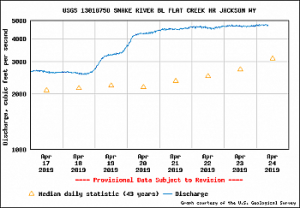
Current Snake River Flows below Jackson
Snake River Fishing Report
4.19.2019
This Snake River Fishing Report is to let you all know that our current guiding plan for the summer season on the Snake River is somewhere between July 4- 10th through October. The flows are ever increasing and we’re expecting them to stay high for the next 45-60 days. The graph below shows the current flow prediction which more than likely will change and as soon as it does we’ll update our guiding plan accordingly. In the meantime please feel free to call us for the latest information and/or to book your trip @ 307-413-0669.

Northwest River Forecast Center
Snake River Jackson Hole Wyoming Fishing Report
4.19.2019
Runoff has begun is the Snake River Jackson Hole Wyoming Fishing Report. As conditions change we will continue to update and our target date to start taking guided trips on the Snake River in Jackson Hole Wyoming is 7.15.2019. Please call 307-413-0669 for updates, information or to book your trip.
(Thursday April 18, 2019)
Subject: 2019 Upper Snake River Operations Update
Purpose: The purpose of these Operation Updates is to provide information regarding Reclamation’s operations as the season progresses. The operations outlined in this update are based on the best data available at the time and are subject to change as new information becomes available. For additional information and resources, please visit our website at: https://www.usbr.gov/pn/hydromet/uppersnake/ .
Jackson Lake Dam
· Current Discharge = 1,050 cfs.
· At 9 am today (4/18) discharge was increased from 700 cfs to 1,050 cfs.
· At 1 pm today (4/18) discharge was increased to 1,400 cfs.
· At 9 am tomorrow (4/19) discharge will be increased to 1,750 cfs
· At 1 pm tomorrow (4/19) discharge will be increased to 2,100 cfs.
Upper Snake River Wyoming Operations Update
April 12, 2019
Subject: 2019 Upper Snake River Wyoming Operations Update
Purpose: The purpose of these Operation Updates is to provide information regarding Reclamation’s operations as the season progresses. The operations outlined in this update are based on the best data available at the time and are subject to change as new information becomes available. For additional information and resources, please visit our website at: https://www.usbr.gov/pn/hydromet/uppersnake/ .
Summary
The Upper Snake reservoir system is currently 83% full (3,336,211 acre-feet out of 4,045,695 acre-feet). Official water supply forecast for the April-July runoff period have been finalized and the information is included in the table below. April precipitation to date has been well above normal and accompanied by overall near-normal seasonal temperatures. The observed precipitation early this week caused stream-flow to briefly surge, but the subsequent cooling trend has caused runoff to trend to just above last week’s levels. The wet and cool trend is expected to continue through Wednesday, with a potential warm up Thursday and into Friday before another cooler system moves through the region.
Jackson Lake’s discharge target was maintained at 700 cubic feet per second (cfs) and is projected to remain steady for this week as well.
Palisades’ releases were increased by approximately 2,800 cfs during the week, and the current discharge target is approximately 9,800 cfs. The reservoir is drafting on a trajectory consistent with current estimates for required flood control levels in early May. Additional increases to discharge are likely next week.
Ririe’s discharge target was maintained at 125 cfs this week. Ririe’s release is expected to remain at the current magnitude until the reservoir reaches approximately 60,000 AF.
Island Park’s discharge target was held steady this week. Island Park’s discharge is expected to remain at the current target until the reservoir reaches approximately 112,000 AF.
American Falls Reservoir’s releases were adjusted downwards early this week to fill the reservoir to acceptable levels. Beginning Thursday, releases were increased to approximately 8,750 cfs. Additional increases are likely for the next week.
Little Wood Reservoir is projected to maintain the current release for the next 3-7 days.
|
Facility |
% Full |
Storage (acre-feet) |
April – July Runoff Forecast % of Normal |
Yesterday’s Inflow (cfs) |
Estimated Outflow (cfs) |
Next anticipated discharge change |
|
Jackson Lake |
78% |
661,231 |
104% |
698 |
700 |
Not scheduled |
|
Palisades |
73% |
875,835 |
99% |
6,426 |
9,800 |
Potential increases in the next 3-7 days |
|
Ririe |
67% |
54,092 |
121% |
279 |
125 |
At content of ~ 60,000 |
|
Island Park |
80% |
108,212 |
115% |
613 |
648 |
At content of ~ 112,000 |
|
Grassy Lake |
88% |
13,314 |
– |
9 |
0 |
Not scheduled |
|
American Falls |
94% |
1,566,029 |
– |
10,197 |
8,750 |
Potential increases in the next 3-7 days |
|
Minidoka |
94% |
89,591 |
– |
5,801 |
7,000 |
+1,250 cfs to 8,250 cfs tomorrow |
|
Milner |
1.1 feet below full |
– |
5,355 |
3,500* *River QD |
+1,000 cfs to 4,500 cfs tomorrow |
|
|
Little Wood |
44% |
13,228 |
141% |
1,119 |
625 |
Not scheduled |
Reservoir levels, reservoir discharge and river flows can be monitored on the USBR Hydromet page here: https://www.usbr.gov/pn/hydromet/
The Upper Snake “teacup” diagram which provides a graphical overview of system conditions can be accessed here: https://www.usbr.gov/pn/hydromet/burtea.html
Snake River Jackson Hole Wyoming Fishing Report
(Friday April 5, 2019)
Subject: 2019 Upper Snake River Operations Update
Purpose: The purpose of these Operation Updates is to provide information regarding Reclamation’s operations as the season progresses. The operations outlined in this update are based on the best data available at the time and are subject to change as new information becomes available. For additional information and resources, please visit our website at: https://www.usbr.gov/pn/hydromet/uppersnake/ .
Summary
The Upper Snake reservoir system is currently 83% full (3,338,896 acre-feet out of 4,045,695 acre-feet). Official water supply forecast the April-July runoff period have been finalized and the information is included in the table below. The forecast for the next 7-10 days indicate persistent precipitation accompanied by cooler than normal temperatures. The cool temperatures and precipitation will likely increase snow-water equivalent above 8,000’ and catalyze runoff in the low to mid elevation bands. Willow Creek and Little Wood basins are expected to observe notable increases in streamflow during the next week. Operational adjustments will be made based on the latest information, and more changes can be expected as reservoir operators gauge the reaction of the runoff to the forecast conditions.
Jackson Lake is projected to maintain the current release until inflow exceeds outflow in the next 2-3 weeks. USGS measured the discharge below the dam, and the new gauge height shift correction computes a flow approximately 85 cubic feet per second (cfs) lower than the previous. The physical discharge from the reservoir was not changed.
Palisades Reservoir is drafting on a trajectory consistent with current estimates for required flood control levels in early May. Palisades Dam’s current discharge is projected to be maintained for the next 3-10 days, or as conditions permit to achieve appropriate progress towards required flood control targets. However, increases to discharge in the next week cannot be ruled out at this point.
Ririe Reservoir has stored approximately 220 AF over the last week. Snow-melt above the reservoir has been increasing and is projected to continue doing so. Relatively cool temperatures so far this spring have kept the above average snowpack in place, and reclamation suspects the runoff period has been condensed versus there being a reduced volume. The ripened snow pack and associated runoff will potentially exhibit volatility in relation to temperatures and precipitation trends over the next 2-3 weeks. Cooler temperatures will lessen the impact of rain on snow, but if warmer temperatures develop quickly, the inflow magnitude will increase accordingly. Considering this, increases to Ririe’s release can reasonably be expected next week.
Island Park Reservoir is expected to maintain the current release until inflow exceeds outflow, and reservoir storage has increased to approximately 108,000 – 110,000 acre-feet.
American Falls Reservoir discharge was reduced by approximately 750 cfs to manage reservoir levels. The Upper Snake Field Office projects American Falls to be near full the first week of May.
Little Wood Reservoir is projected to maintain the current release for the next 7-10 days.
|
Facility |
% Full |
Storage (acre-feet) |
April – July Runoff Forecast % of Normal |
Current Inflow (cfs) |
Current Outflow (cfs) |
Next anticipated discharge change |
|
Jackson Lake |
78% |
658,807 |
104% |
445 |
689 |
Not scheduled |
|
Palisades |
75% |
899,125 |
99% |
4,055 |
7,008 |
Potential increases in the next 3-7 days |
|
Ririe |
65% |
52,419 |
121% |
95 |
53 |
Likely in 3-7 days |
|
Island Park |
80% |
107,858 |
115% |
626 |
662 |
Not scheduled |
|
Grassy Lake |
88% |
13,314 |
– |
9 |
0 |
Not scheduled |
|
American Falls |
91% |
1,521,159 |
– |
8,303 |
8,250 |
Potential reductions in the next 3-7 days |
|
Minidoka |
91% |
86,214 |
– |
8,899 |
8,250 |
Potential reductions in the next 3-7 days |
|
Milner |
1.1 feet below full |
– |
9,975 |
6,640* *River QD |
Potential reductions in the next 3-7 days |
|
|
Little Wood |
21% |
6,153 |
141% |
435 |
350 |
Not scheduled |
Reservoir levels, reservoir discharge and river flows can be monitored on the USBR Hydromet page here: https://www.usbr.gov/pn/hydromet/
The Upper Snake “teacup” diagram which provides a graphical overview of system conditions can be accessed here: https://www.usbr.gov/pn/hydromet/burtea.html
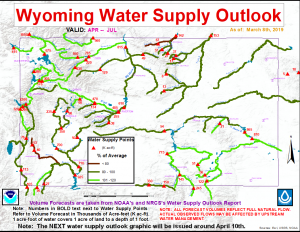
WATER!!!!
3.26.2019
Wyoming Water Supply Outlook
HIGHLIGHTS:
…Wyoming February 2019 precipitation was 115 to 125 percent of average…
…Current water year precipitation is averaging 100 to 110 percent of normal across Wyoming…
…Mountain snowpack across Wyoming is 105 to 115 percent of median…
…Near normal to slightly above normal snowmelt streamflow volumes are expected across several major basins in Wyoming…
…Total reservoir capacity across Wyoming continues to be 70 to 75 percent by early March…
SYNOPSIS:
February 2019 precipitation totals across Wyoming were 115 to 125 percent of average. Precipitation numbers varied between 250 percent of normal over the Snake and Upper Yellowstone River Drainages (west to northwest Wyoming) to near 50 percent of average over the Tongue River Basin (north central Wyoming). Current water year (October 2018 – February 2019) precipitation across Wyoming was 100 to 110 percent of average.
Mountain snowpack across Wyoming was 105 to 115 percent of median by early March. Snowpack “water” numbers and/or SWEs were the highest across basins in southeast and western Wyoming—varying between 110 to 130 percent of median. SWEs across basins in north central Wyoming were 80 to 100 percent of median.
Near normal to slightly above normal (95 to 105 percent) snowmelt streamflow volumes are expected across several major basins across Wyoming. Above average snowmelt streamflow volumes are expected across the Snake, Shoshone, Upper North Platte and Laramie Watersheds. Several rivers along the Tongue, Powder, and Upper Green Basins are forecasted to have below normal streamflow volumes during the upcoming snowmelt season.
Total reservoir capacity across Wyoming continues to be 70 to 75 percent by early March. Reservoir storages across Wyoming remain above average at 105 to 115 percent for March.
2019 Upper Snake River Operations Update
The following email update is from the Bureau of Reclamation, which outlines the current plan. Please keep in mind it can change on a moments notice due to changing weather and water conditions. Their preliminary thought on the Snake River Dam releases is that the releases would probably increase starting in Mid-April but are not certain yet. As soon as we get the next update we’ll share it on this page.
(Friday March 22, 2019)
Subject: 2019 Upper Snake River Operations Update
Purpose: The purpose of these Operation Updates is to provide information regarding Reclamation’s operations as the season progresses. The operations outlined in this update are based on the best data available at the time and are subject to change as new information becomes available. For additional information and resources, please visit our website at: https://www.usbr.gov/pn/hydromet/uppersnake/ .
Summary
The Upper Snake reservoir system is currently 85% full. There is a high likelihood of an increase of approximately 2,000 cfs for Palisades Dam next week. Estimates of the upcoming Heise April 1 runoff volume forecast along with precipitation forecasts will be examined further before determining flow changes from Palisades next week. If outflow from Palisades is increased next week, then increases in discharge may be made at American Falls Dam and Minidoka Dam next week. Island Park will see a small increase of 50 cfs Monday 3/25 which will increase its draft rate up to approximately 450 acre-feet per day in anticipation of an above average spring runoff. Ririe Dam will see its first discharge of the year going to a total outflow of 50 cfs on Monday 3/25 in anticipation of runoff picking up in the next few weeks. An increase at Little Wood Dam is likely next week as inflows are expected to pick up more next week. Short-range forecasts indicate below average temperatures and above average precipitation conditions across the Upper Snake and Little Wood watersheds.
|
Facility |
% Full |
Storage (acre-feet) |
% of Daily Median Snowpack |
Current Inflow (cfs) |
Current Outflow (cfs) |
Next anticipated discharge change |
|
Jackson Lake |
79% |
667,000 |
113% |
500 |
775 |
Not scheduled |
|
Palisades |
82% |
985,100 |
110% |
3,000 |
5,500 |
Next week to approx. 7,500 cfs |
|
Ririe |
64% |
51,900 |
124% |
40 |
0 |
+50 cfs to 50 cfs Mon 3/25 |
|
Island Park |
83% |
111,800 |
127% |
500 |
650 |
+50 cfs to 700 cfs Mon 3/25 |
|
Grassy Lake |
87% |
13,200 |
107% |
10 |
0 |
Not scheduled |
|
American Falls |
92% |
1,534,000 |
115% |
8,500 |
9,000 |
Next week to approx. 11,000 cfs |
|
Minidoka |
91% |
86,200 |
– |
9,200 |
9,200 |
Next week to approx. 11,000 cfs |
|
Milner |
0.9 feet below full |
– |
9,200 |
8,200 |
Not scheduled |
|
|
Little Wood |
26% |
7,900 |
136% |
93 |
300 |
Not scheduled |
Reservoir levels, reservoir discharge and river flows can be monitored on the USBR Hydromet page here: https://www.usbr.gov/pn/hydromet/
The Upper Snake “teacup” diagram which provides a graphical overview of system conditions can be accessed here: https://www.usbr.gov/pn/hydromet/burtea.html
Snake River Fishing Report
3.9.2019
For all of you who are basking in the sun asking about the current fishing conditions, here’s the latest Snake River Fishing Report…….these pics were taken yesterday on the Snake River………the fish were sippin some small midges so several of our guides went out today to give them a go. More reports to follow.
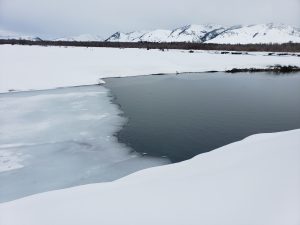
Snake River March 9 2019
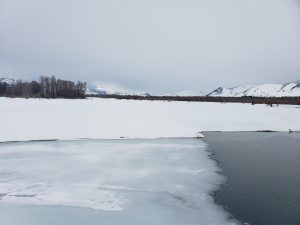
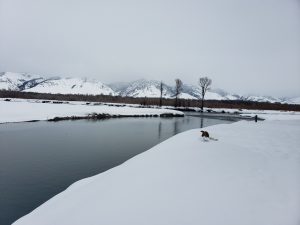
1.8.2019
We have an incredible amount of water stored already in the Upper Snake River Basin and it’s only the 8th of January! Wahoo. We’re ready when you are so please give us a shout to catch up on the latest and greatest or to book your trip @ 307-413-0669 or email; [email protected].
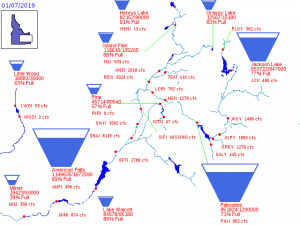
Upper Snake River Water Supply
Bureau to cut Snake River flows below Jackson Lake Dam
- By Mike Koshmrl Jackson Hole Daily
- 0
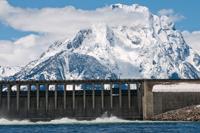
Water releases out of Jackson Lake Dam, pictured, began dropping toward a winter flow rate on Monday, and will continue tapering through the middle of next week.
The Bureau of Reclamation’s annual fall tapering of water releases from Jackson Lake Dam began Monday and will continue through the middle of next week.
Discharge from the dam into the Snake River was around 1,800 cubic feet per second this past weekend, but it fell to 1,550 cfs by the end of Monday. The schedule calls for another drop to 1,300 Tuesday, 1,100 by Wednesday, 900 by Thursday and 750 by Friday. Flows will hover at that level for the weekend before dropping to 600 cfs on Oct. 1, 450 on Oct. 2 and to the final winter flow rate of around 350 to 450 cfs come Oct. 3.
Although the Snake will pick up another 350 cfs or so after the Buffalo Fork and Pacific Creek confluences, the result will be decidedly slower floats in Grand Teton National Park and further downstream.
Jackson Lake, currently 78 percent full, is about as flush as it can be per the terms of a flood control agreement with the U.S. Army Corps of Engineers.
“It was a good water year, and we try to keep the water as high in the system as we can,” said Brian Stevens, the bureau’s Upper Snake Field Office water operations manager.
Before entering Palisades Reservoir, the Snake is carrying around 3,850 cfs. Short of a big rain event, Snake River Canyon flows stand to drop to 2,500 cfs by the middle of next week. Palisades on Monday was 55 percent full and discharging 7,000 cfs, which is significantly more water than it was receiving from the Snake, Greys and Salt river inflows.
Snake River Wyoming Fishing Report

Snake River 2018
9.10.2018
Flows at Moose:2900 CFS
Flows below Jackson: 3420 CFS
The Snake River Wyoming Fishing Report is all kinds of good news! LOTS of water still flowing and LOTS of bugs happening! The best action is from mid morning once the water temps rise until late afternoon. There’s tons of pmds, stones, hecubas, mahogany duns, Snake drakes and hoppers too on the warm sunny afternoons. Look for the fish to be chowing the bugs below the riffles, particularly in the foam lines. There are plenty of fish to be found long the banks too. With each passing day we’re seeing more and more “yellow bellies”, which refers to the larger, more mature fish which are returning to the main stem of the Snake River from the tributaries.

Yellow Belly
To book your fall fishing trip please call us @ 307-413-0669 or email; [email protected].
Snake River Fishing Report

Snake River Fine spotted Cuttie 8.16.2018
8.16.2018
Flows at Moose: 2610 CFS
Flows south of Jackson: 3080 CFS
The Snake River Fishing Report is we’re super psyched for the rest of the season. With the cooler temps forecasted being right around the corner and the water supply is plentiful the fall fishing is gonna be awesome! How can you beat large sipping trout, elk bugling and golden aspen leaves? The fish caught today ate a small pmd.

Plenty of Water for the Fall fishing
Please give us a call @ 307-413-0669 to book your trip or email; [email protected].
Snake River Fishing Report
6.20.2018
The latest Snake River Fishing Report shows what a roller coaster ride it’s been so far. We’re still thinking that RDA will be guiding trips on the Snake River on or about 7/10/2018. To book your trip or to get the latest please call us @ 307-413-0669 or email;[email protected].

Snake River Forecast
Snake River Fishing Report
6.14.2018
Flows at Moose: 8490 CFS
Flows below Jackson: 10,300 CFS
The latest and most up to date Snake River Fishing Report today is the flows have reduced significantly. See the chart below.

Snake River Flows 6.14.2018
We’re still going to let the Snake River calm down before we even attempt a exploratory trip. We want and will make certain that you will have a legitimate shot at catching fish before we take a paying trip down the Snake River in Jackson Hole Wyoming. Our goal is for you to be able to enjoy your day on the water as we can appreciate that you’re trusting us to put you on fish!
Our best guess is at least 7-10 days before it’s up to our standards. There are other outfitters who are already out there as they are every year. We have much better options only a short drive away to the Reel Wyoming!
Please call 307-413-0669 to get the most up to date info or email; [email protected].
Snake River Fishing Report
6.2.2018
Flows in Moose; 12,900 CFS
Flows below Jackson: 19,300 CFS
The Snake River Fishing Report is still an update with the flows seemingly peaking after the increase in flows out of the Jackson Dam and all of the rain over the past week or so. At this point we’re thinking that the Snake River will be fishing up to our standards by early July, give or take a few days. Regardless, there will be PLENTY of water for a solid fishing season well into fall. Jackson Lake is 98% full!

Snake River Flows
Please give us a call to catch up on the latest or to book your trip @ 307-413-0669 or email; [email protected].
Snake River Fishing Report
5.21.2018
Todays Snake River Fishing Report is still more of an update. Looking at the flow charts below you can easily see how high the flows are currently. The peak flows should be occurring over the next 2 weeks at or near 20,000 cfs.
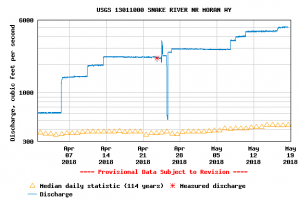
Current Jackson Dam flows
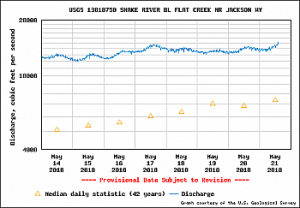
Snake River flows below Jackson
Based on these projections shown below, currently we’re thinking we’ll be guiding on the Snake River in Jackson Wyoming around the 10th of July. To book your trip or to get the latest please call us at 307-413-0669 or email; [email protected]

Snake River projected flows
Snake River Fishing Report
5.11.2018
The Snake River Fishing Report is an update of some extremely high flows currently. When you look at the top chart we’re thinking that we’ll possibly be guiding on the Snake River in Jackson Wyoming around the 10th of July. Stay tuned for more updates as the conditions change or to book your trip for this season. Contact us at 307-413-0669 or email; [email protected].


Snake River Fishing Report
4.29.2018
The latest Snake River Fishing Report is really an update since the rivers are are completely blown out. Currently the flows are super high due to unseasonably high temperatures and it hasn’t froze for several nights in a row. Here in lies why predicting a start date requires an algorithm which is exponentially complex. Given this info, we’re still planning to guide on the Snake River in early to mid July this year. You can see how high the flows are looking at the charts below. In the mean time, we’re booking up fast for the upcoming season and still have availability as of now so please give us a call to reserve your trip. Email; [email protected] or phone 307-413-0669. Please feel free to give us a shout to check in on the latest and most recent reports form the rivers.


Snake River Fishing Report
4.14.2018
Snake River Fishing Report and River update: Based on the most current information provided in the chart below, we’re predicting that Reel Deal Anglers will start guiding around the 15th of July. I hope everyone can appreciate that this information may and probably will change several times, if not more, as the runoff kicks into gear. There are so many factors involved in making these decisions that all we can do is mull over the most current and reliable information that’s provided by various entities of the USA government. What I can tell you is, we don’t take any trips on any river until we feel 100% confident that you will have the opportunity to have the best day possible to catch fish and have fun. Stay tuned for more details! Please call us for an up to date report or shoot us an email @ [email protected]. We’re right in the middle of the heavy booking season, so please contact soon to get your preferred slot.

Snake River Fishing Report
4.9.2018
Here’s the latest from the Bureau of Reclamation……….
Summary
Relatively high forecasted snow accumulation above Palisades Dam in the near term on top of already high runoff volume forecasts may require additional discharge increases from Jackson Lake Dam and Palisades Dam next week for flood control purposes. Depending on how future precipitation patterns look after next week and how much precipitation actually accumulates over the next week will fine tune operational decisions in the short term. The only planned flow changes at this time are the following:
Jackson Lake Dam
· Current Discharge = 1,500 cfs. Reclamations April through July runoff volume forecast for Jackson Lake Dam is 929,000 acre-feet which is 121% of the 1981-2010 average. Current flood control targets for Jackson Lake Dam in the early May time frame are in the 600,000 acre-feet range (71% full). As April progresses flood control targets will be rechecked and adjusted based on additional precipitation and weather outlooks. The lower gates at Jackson Lake Dam will be exercised on April 24th and April 25th. On these two days outflows will rise and fall as necessary to test all the lower gates. This gate exercising is part of a regularly scheduled gate maintenance program.
· Current Storage = 656,000 ac-ft (77% full)
· Current inflow (5-day average) = 726 cfs (1981-2010 average = 600 cfs)
Snake River Spring Fishing Report
Flows at Moose: 1200 CFS
Flows below Jackson: 1700 CFS

Jimmy B Getting it done on the Snake River
Here’s our first Snake River Spring Fishing Report and a few photos from the Snake River. The action last week was very inconsistent bugs and fish activity during the few warmer days we had. Jim and I went out 3 out of the 4 nice days, but did more walking than fishing. Water temps are still very cold. The fish we did hook were very slow and lethargic. Weather is back to winter-like this week. Next warm up we get, we will be back out there and hopefully will have a better report for you.

Brother Josh enjoying the action
We’re currently booking guided trips for the summer season so please give us a call to book your trip or catch up on the latest at 307-413-0669 or [email protected].
Snake River Fishing Report/Update
February 8, 2018
Snake River Fishing Report/Update: As of today the Upper Snake River drainage is sitting pretty at 87% with the collective snowpack at 120%. Check out the graphic below:
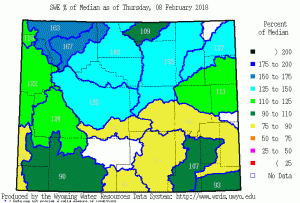
Current Wyoming Snowpack

Curent Upper Snake River Water Storage
Currently the fishing on the Snake River has been very good and consistent due to the mild winter and temperatures. The Midge hatches have been prolific in the mid day hours. Look for the nymphing to be best below and in the riffles and the surface action mostly in the polls and eddy lines. When the water temps are warmer the streamer bite has been getting more consistent.
Try using gnats, parachute midges, skittering midge, bobs 5 second midge and matts midges for dries, size 18-22. Nymphs; try the zebra midge, jays sparkle midge and disco midge. Streamers; Try either a olive, black bugger or any type of small sculpin imitation.
The nymph rig we’ve been using is a 7 ft 4x leader with a pheasant tail as the point fly and the midge as the trailer. The indicator and weights should be able to be moved to compensate for the variable depths of the riffles. ALWAYS REMEMBER TO REMOVE YOUR GLOVES WHEN HANDLING THE FISH! THIS ALLOWS THE FISH’S SLIME TO STAY ON THEIR BODY THEREFORE GIVING THEM A MUCH BETTER SURVIVAL RATE.
We’re currently booking the summer season for 2018 and looking forward to having you out for a day of guided fishing. Please call us @ 307-413-0669 or email [email protected].
Snake River Fishing Report
1/8/2018
HAPPY NEW YEAR EVERYONE!
Great news……we have plenty of water that was mostly hold over from the past year’s deluge. As of today, the Upper Snake Drainage has 87% of storage and the snowpack is currently sitting just above 100% of a 30 year average. Check out the two charts/graphs below to illustrate my reported numbers.

Upper Snake Storage

Wyoming Snowpack
We are currently booking for the 2018 season; so please feel free to contact me with questions @ 307-413-0669 or [email protected].
Upper Snake River Storage Numbers
Here’s the updated information on the Upper Snake River Storage Numbers. As of today the entire system is sitting at 75% of capacity, which is fantastic for this time of the year.

Upper Snake River Storage Numbers
Snake River Fishing Report
8.22.2107
Flows at Moose: 3660 CFS
Flows below Jackson: 4050 CFS
As we all know water is the key element required and the great news on todays Snake River Fishing Report is, WE HAVE LOTS OF IT!!!!! The entire storage level sis at 80% as of today. Check out the diagram below.

Upper Snake River Storage Diagram
The fish have now moved into the banks and are taking the big bugs all day long and the tighter to the banks your fly is wins the bigger fish! Look for caddis in the early am and late pm. During the day the pmds and classenia stones along with hoppers are the ticket. On the hotter and brighter afternoons adding a dropper below your big bug keeps you in the game all day long.
RDA is booking into the fall so please give us a call to book your trip b/c this will definitely be a September to Remember! 307-413-0669 or email; [email protected].
Snake River Fishing Report
Flows at Moose: 3600 CFS
Flows below Jackson: 4210 CFS
The Snake River Fishing Report today is the conditions are improving every single day and the bigger fish are starting to look up and move in along the banks. We’re seeing PMD’s in the morning along with a few caddis with the fish keying in on them until late morning. Grasshoppers are definitely becoming the go to bug, especially on the warmer afternoons. Getting your bug tight to the bank and using a small twitch can reward the angler who’s not afraid to donate a few.

Snake River Cuttie
Dropping a p tail or copper john on the warmer afternoons can keep the action going as will a streamer as well. There are reports of the classenia stone being on the surface here and there. ALSO, don’t forget to break out the power ants, in cinnamon and black too. Especially around the structure. Every day seems to be a different scenario so be flexible and keep your line wet!
To book your trip please call us @ 307-413-0669 or email; [email protected]
Snake River Fishing Report
8/3/2017
Flows at Moose: 3950 CFS
Flows below Jackson: 4590 CFS
FINALLY!!!!! The Snake River Report is the flows have finally come down to a 30 year average, which means the larger fish are starting to look up! FINALLY. RDA has only done several trips on the Snake River this season but we’re now out there on a daily basis and plan to continue to do so until late fall. Speaking of, the fall will be EPIC fishing conditions and void of the masses too.
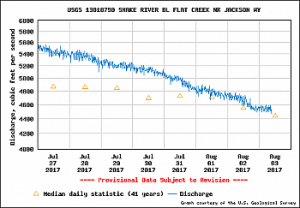
Current Snake River Flows

Snake River Cuttie 8/2/2017
Not too much to report on bug other than a few pmds and caddis and some hopper action in the afternoons. Dropping a pheasant tail, copper john or hares ear keeps you in the game all day long. Make your casts as close as possible to the structure and/or the banks for the best opportunities! The fish are still in the slower and deeper water and are making the transition to their typical holding spots on the seams, riffles and eddys now.
We are currently offering an Eclipse special for 8/21. Our full day experience with a gourmet lunch served after the eclipse has passed @ $750!
To book your trip please call us @ 307-413-0669 or email; [email protected]. Thank you and enjoy!
Snake River Fishing Report
7.19.2017
Just as I hit send a few minutes ago on our latest Snake River Fishing Report, this came in from the Bureau of Reclamation.
Jackson Lake Dam discharge will be decreased by 900 cfs tomorrow and another 900 cfs on Sunday to reach the 2017 target summer flow of 2,500 cfs by the end of Sunday.
We are planning on keeping 2,500 cfs running out of Jackson Lake through the rest of July, August and most of September.
After the water flows settle down from the reductions mentioned above, we are going to commence to guiding on the Snake River. Our anticipated date to start our guided trips on the Snake River is: 7/26/2017. We thank you for your business and look forward to several incredible months opf fishing on the Snake River this season. To book your trip or to get the latest info please call 307-413-0669 or email: [email protected].
Snake River Fishing Report
7.19.2017
Flows at Moose: 6360 CFS
Flows below Jackson: 7460 CFS
Our Snake River Fishing Report today is we’re still not ready to take paying clients out for another few days, at least. We’re sending one of our guides out on Friday who’s been guiding the Snake River for 25 years now to give us his assessment. We know, for a fact, that a quality opportunity and experience is very limited, if not even a possibility. Comparing the Snake River to the Green, New, Fork or Salt Rivers is not even a question given the yield of catching vs a float trip.

Snake River Photos from 7.18.2017

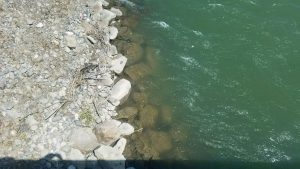
We’re offering a 3/4 day experience on the Salt, Green or New Fork Rivers for $525, which includes a delicious lunch, to satisfy the folks who are looking for a quality experience and don’t have the entire day to commit to. Please call 307-413-0669 or email: [email protected] to get the latest or book your trip. We are firmly adhere to “doing the right thing” and following best ethics practices when considering our clients’ hard earned money and valuable time.
Snake River Fishing Report
7.16.2017
Flows at Moose: 7840 CFS
Flows below Jackson: 9010 CFS
The Snake River Fishing Report is the Jackson Dam flows have been reduced by 2000 cfs over the past 36 hours, which will help the river settle down and clear.
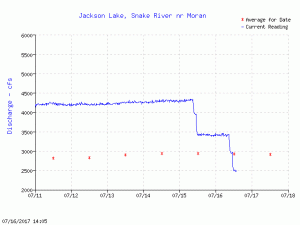
Jackson Dam flows
BUT, it is important to note that the flows are still running almost double of the 30 year average.
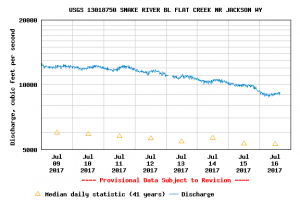
Flows below Jackson
At this point we still feel that the Snake River is not up to our standards to take paying clients out on just yet. We’re considering later this week and it just might be, but that remains to be seen. The one option on the Snake River is the Dam to Pacific section which has seen more of a boat hatch than ever before.
What we do know is that there will be PLENTY of water for the rest of the season!!! Check out this graphic below.

Snake River is sitting at 98% of capacity.
We are currently booking our Snake trips from 7/24 up until late October so please give us call @ 307-413-0669 or email; [email protected] to book your trip. Tight lines!!!
Snake River Fishing Report
Flows at Moose; 9390 CFS
Flows below Jackson; 11,300
The Snake River Fishing Report today is we’re sending a guide out tomorrow to check out the conditions. There are many outfitters already out there but we are hesitant to take guided trips out until the conditions meet our standards. We will be back in touch after his trip report.
We are booking from mid July through October so please give us a call @ 307-413-0669 or email; [email protected].
Snake River Fishing Report
6.26.2017
The Snake River Fishing Report is; it’s gonna be a great season once the flows settle down. We’re booking trips from mid July until October.

upper snake river maxed out full
To book your trip please call 307-413-0669 or email; [email protected].
Snake River Fishing Report
6.16.2017
Flows at Moose: 11,100 CFS
Flows below Jackson: 14,300 CFS
Once again, this Snake River Fishing Report is much more akin to a flow report. Given this info we’re still planning on getting out to guide somewhere around the middle of July.

Snake River Flow Prediction
To book your trip for this summer or to get the latest update please call us @ 307-413-0669 or email; [email protected].
Snake River Fishing Report
6.4.2017
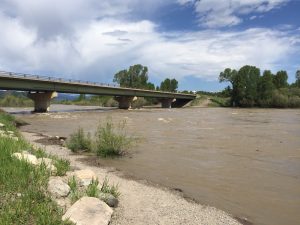
Snake River at South Park Bridge
Flows at Moose:15,400 CFS
Flows Below Jackson: 20,500 CFS
The current Snake River Fishing Report in Jackson Hole is more of a flow update. Here’s a short video showing the flows at the South Park Bridge IMG_9811.MOV. Check out the charts below showing the projected vs actual flows and you’ll see why it’s so complicated to project when we’re going to have quality water to guide on.

Projected vs Actual Flows

Current flows vs the 30 year average
Meanwhile, the flows are HUGE right now. Be careful in and around the river as it is VERY dangerous. See the flood alert below:
Severe Weather Alerts – Jackson, WY
-
Areal Flood Watch
Areal Flood Watch in effect until Wednesday, 6:00 AM MDT. Source: U.S. National Weather Service
…FLOOD WATCH REMAINS IN EFFECT THROUGH LATE TUESDAY NIGHT…
The Flood Watch continues for
* Portions of northwest Wyoming and west central Wyoming,
including the following areas, in northwest Wyoming, Absaroka
Mountains and Jackson Hole. In west central Wyoming, Upper
Green River Basin and Upper Green River Basin Foothills.
* Through late Tuesday night
* Accelerated snowmelt runoff due to warm afternoon mountain
temperatures will continue through Tuesday. Expect continued
sharp increases in creek and river levels Monday morning
through Tuesday afternoon.
* Along the Snake River Basin: Flooding of low lying areas is
expected on smaller creeks and streams to include Pacific Creek,
Buffalo Fork, and the Gros Ventre River. Minor flooding is also
expected along the Snake River from Moose to near Jackson Monday
morning through Tuesday evening. The flow along the Gros Ventre
River near Kelly is expected to increase to 6,000 to 6,500
cubic feet per second (cfs) by Tuesday morning. The flow along
the Snake River near Jackson is expected rise to near 25,000
cubic feet per second (cfs) by Tuesday afternoon.
Currently our best guess is that we’ll be guiding on the Snake River around mid July. Please give us a call @ 307-413-0669 or email [email protected] to get your trip booked or to get the latest and greatest information. Take care and tight lines!
Snake River Fishing Report
5/17/2017
Flows at Moose Wyoming: 7300 CFS
Flows Below Jackson: 10,300 CFS
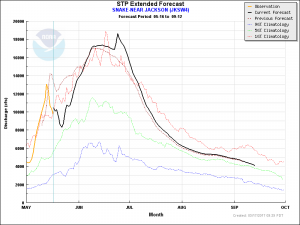
Predicted Snake River Flows
Snake River Fishing Report: Todays report is more of a flow and runoff prediction update. As you can see from the updated flow prediction changes each week I post. This is why it’s so complicated and challenging to predict when we’re going to have quality fishing water. I’m asked this question about 20-30 times per day. By the looks of this chart, we’re still focused on starting to guide on the Snake River in mid July. Currently the Snake River is cooking and look for it to really get going in the next few weeks. the Bureau of Reclamation has said that they’re looking at boosting the flows out of the Jackson Dam to somewhere between 5000-8000 CFS. These predicted flows along with the tributaries below the dam should get the flows really high and borderline flooding, if the temperatures get too hot and cause a rapid melt. Until next time…….take care.
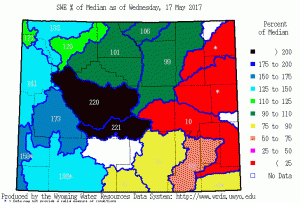
Current Wyoming Snowpack
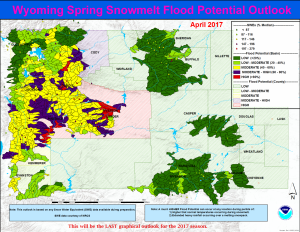
NOAA Flood Predictions
Stay tuned as this will all change as soon as I click publish! To book your trips or to get the latest please give us a call @ 307-739-7020 or email rhett@reeldealanglers. Take care and tight lines!
Snake River Jackson Hole Fishing Report
5/10/2017

Predicted Snake River Flows 5/10/2017
Currently, the Snake River Jackson Hole Fishing Report is very high flows and there’s still a ton of snow to melt as you can see illustrated in the chart below. However, the Snake River is fishing good below the Dam to Pacific Creek, where is gets really muddy. The fare is nymphing in the top section and streamers as it gets slower about midway down towards the cattlemans bridge. There’s a few skwallas around and caddis are starting to get plentiful day the day along with some bwos as well.
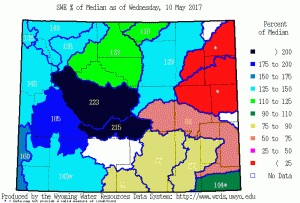
Current Wyoming Snowpack 5/10/2017
Looking at the chart below, the Snake River is running 2.5 times more than the 30 year average. Based on the most current data, Reel Deal Anglers is not planning to guide on the Snake River until mid July, at the earliest.

Current Snake River Flows 5/10/2017
To book your trip or to get the latest updates please call us @ 307-739-7020 or drop us an email @ [email protected]. We look forward to getting you out on the water for a great day!
Snake River Fishing Report
5/4/2017
The current Snake River Fishing Report is get ready and buckle up for the spring runoff. With the temps today getting into the upper 60’s and it won’t freeze tonight for the first time in a long time, look for the river to be completely blown out soon. After such a huge winter snowpack full of moisture, it’s time for the melt in the high country to commence.
Based of the flow predictions below we’re not planning to get out to guide on the Snake until mid to late July. Not to worry as we have a lot of other great options such as the Green and New fork rivers.

Projected Snake River flows
To book your summer trip or check in and get the latest updates, please give us a call @ 307-739-7020 or email; [email protected]
Snake River Fishing Report
3.28.2017
This was the reply today from the Bureau of Reclamation on my question for an update on the Upper Snake River Dam Operations; ” We are keeping Jackson at 3500 for awhile and also palisades steady at 18,000 cfs.”
With this being said the Snake River in the Jackson Hole area along with it’s tributaries are all running very high but are hit and miss each day with the varying spring temps. We are running trips on a day to day limited basis. To give you an idea the graph below shows the current flows, which are near 5500. the 30 year average flows are 1500 so you can see the volume of water is quite significant.

Current Snake River Flows Below Jackson
What’s most important to remember is the flows being consistent and the water being clear enough for the fish to see the flies. This is why we’re running our operation and a day by day basis. If you’re wanting to get out this spring please give us a call @ 307-739-7020. We’re also booking for the summer season and there are some prime spots still available! Tight lines and happy spring!
3/1/2017
Snake River Fishing Report
WATER WATER AND MORE WATER!!!!!!

We have WATER!!!!
The Snake River Fishing Report for now is; get ready to see the flows start to increase out of the Jackson Dam. Maybe as early as next week. The Bureau of Reclamation has already started moving water downstream and most likely this will continue for awhile. The Snowpack for the Upper Snake River is sitting at 156% currently and the Snake River system is 70% full, which is significant.

Upper Snake River Teacup Diagram
The fishing/catching on the Snake River has been spotty at best with a very limited window coming in the mid afternoon hours. We’ve seen a few fish taking midge emergers in the back waters in the slow, deep pools right in the foam line. Keep in mind the water temps are still very cold so the fish are still lethargic most of the time. As conditions change we will be updating them on a more frequent basis as we draw nearer to our summer season.
We still have prime spots available so please give us a call @ 307-413-0669. Take care and tight lines!
8.28.2016
Snake River Fishing Report

Brian Chamberland getting his client on a dandy
Flows at Moose: 3680 CFS
Flows below Jackson: 3170 CFS
The Snake River Fishing Report today is we are feeling very fortunate to have good water(temps and flows) for the current fall like conditions. We’ve gone from an early morning start to a mid morning start due to the lower water temps. The best dry fly action has been from around 10am until about 4pm. Adding a dropper in the early am can help get the bite rolling and we’re still seeing a few caddis and pmds but the main course for the dry action is the Snake Drake, Tricos, Stoneflys, Ants and some hoppers too in the warmer afternoons.

First day fly fishing success
Check out the water temp graph below which illustrates the past 60 days on the Snake River. You can easily see the days when the water got above 65 and now they’re barley getting above 60, which is ideal!
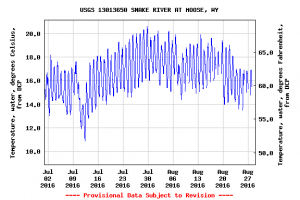
July and August Water Temps
With these cooler temps come great hatches and fish that are feisty and active. The hordes of crowds have dissipated as well, so the fall fishing is setting up to be nothing short of spectacular. We still have some availability, especially in the first week of September, so please give us a shout to book your fall fishing trips @ 307-739-7020! Thank you and tight lines!
8.14.2016
Snake River Fishing Report

Shiny Happy People
Flows at Moose: 3220 CFS
Flows below Jackson: 3340 CFS
The Snake River is in fine form and fishing well. On the cooler mornings the action might be delayed until the sun warms up the water a bit and if the day is really warm and sunny, then it’s likely the water will hit the high 60’s so please, stop fishing if that’s the case. Today we saw a few hecubas, which the fish seemed to be quite focused on all day long. There are also pmds, caddis and of course hoppers too. Everything has been early this season so be ready for anything to happen on any given day. The forecasts look to have the evening temps drop, which will only make the fishing better!!
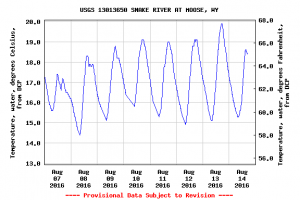
This past week’s water temps
We are currently booking into October so please give us a call @ 307-739-7020 to book your trip or just to catch up on the latest report from the river.
8.5.2016
Flows at Moose:3380 CFS
Flows below Jackson: 3360 CFS
The Snake River Fishing Report from yesterday is we’re gaining on it! The temperatures are cooling off, THANKFULLY! Hopefully the trend will continue. The dry fly bite is still really good during the mid day and look for the terrestrials in the afternoons during the hottest part of the day. A dry/dropper in the early am is sure to get your day off to a good start.
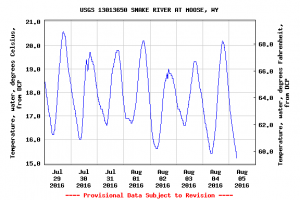
Snake River Temps
Please give us a call @ 307-739-7020 to book your trip or catch up on the latest Snake River Fishing report from the river. Keep them tight and remember, tug is the drug!
8.1.2016
Flows at Moose: 3490 CFS
Flows below Jackson: 3950 CFS

Atta Girl!!!!
The latest Snake River Fishing Report is get up early and git ‘er done! The waters have been warming up in the afternoon, so we’ve been getting our clients on the water by 7;30am and off by 3pm ish. Once the water nears 70 degrees, the fishes metabolism gets stressed and the survivability rate drops significantly during every catch and release. Trout survive best at a temperature around 60F, so you can see the temps on the chart below from the past week and why we fish when and how we do. The storms that rolled through this afternoon really helped cool off the water, thankfully! PMD’s, caddies and yellow sallies are the fare throughout most of the day and when the hatches slow down, it’s time to break out the foam and hoppers! If it’s really slow, then add a dropper several feet off of the back of the big bugs.
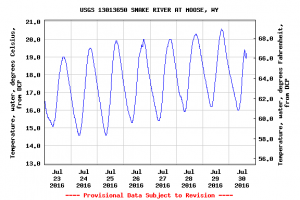
Snake River Water Temp Report
Please give us a call @ 307-739-702o to check in to see what the latest Snake River Fishing Report is from the river and/or to book your trip. Keep them lines tight!
7.21.2016
Snake River Fishing Report
Flows at Moose: 3660 CFS
Flows below Jackson: 4350 CFS

Atta boy
The latest Snake River Fishing Report is the hoppers are starting to come out which is bringing the larger fish to the surface! We’re seeing yellow sallies and pmds as well. Fish are concentrated in the head of the riffles, seams and tucked in near the structure. If you’re willing to get out of the boat and walk down side channels you only increase your chance at a really nice fish. The fish are really eating the foam as the afternoon temps heat up and the best action on the surface has been from around 8am-2pm. We’re trying to get our clients on the water by 7;45am at the very latest.

Nice on Nick!
Give up a call to book your trip @ 307-739-7020! Tight lines and enjoy!!
7.10.2016
Snake River Fishing Report
Flows at Moose: 4010 CFS
Flows below Jackson: 4650 CFS

Nice Cuttie! Ain’t life grand.
The Snake River Fishing Report for Jackson hole Wyoming is that its getting into its prime now. The larger fish are recovered from the spawn and are moving back into the main stem of the river. They are starting to fill in on the banks throughout the river and are aggressively taking the dry flys. We’re seeing pmds, yellow sallies, small stones and a few caddis later in the afternoon/evening. The bigger fish are taking the various foam patterns as well. The cast that’s closest to the bank is the winner and keep your fly in the foam, as we all know; FOAM IS HOME! Expect a change in the hatch times as this upcoming front rolls through and as the week warms up the hatches should return to the “normal” hours. On the hot and sunny days the bite has been best from mid morning until mid afternoon then taking a hiatus until the late evening. When the bite slows down on the dry fly try putting on a dropper or stripping a streamer.
To book your summer fishing adventure on the Snake River please give us a call @ 307-739-7020. Take care and tight lines!
6.17.2016
Snake River Fishing Report
The Snake River Fishing Report for Jackson Hole Wyoming is fishing season is right around the corner! Based on what we know, collectively, we will start guiding clients on the Snake for sure starting 6/27 but we might several days prior, based on what happens over the next few days. Here’s the latest in the article in todays JH News and Guide. Please give us a call @ 307-739-7020 to book your trip.
Snake levels plunge
By Mike Koshmrl Jackson Hole Daily | 0 comments
Releases from Jackson Lake Dam have dropped to near their long-term summer levels and tributaries are easing up, too, a combination that bodes well for anglers feeling the itch.
Snake River levels at South Park have dropped by a third in the last five days to about 7,500 cubic feet per second, and flows that ran turbid not long ago are beginning to show signs of clearing. Fishing guides in the community say the Snake is on the cusp of being in prime condition.
“It’s still a little high, a little quick and a little off color, but people are catching fish,” Westbank Anglers owner Baker Salsbury said. “So, go for it.”
Elsewhere, like on the Snake’s South Fork past Palisades Reservoir and on select streams in the Jackson Hole area, the waters are already clear and the bite plenty strong, he said.
Between Monday and Tuesday the Bureau of Reclamation cut the release rate at Jackson Lake from 3,250 to 2,600 cfs. The quickly diminishing snowpack and reduction in runoff prompted the change, Upper Snake Water Operations Manager Mike Beus said.
“Inflow fell off dramatically the end of last week, so we had to follow it,” Beus said. “Otherwise we’d be moving water downstream that we don’t want downstream yet — water that we’d rather float on in August.”
The near-average snowpack disappeared quicker than expected this spring. By last week significant snowfields were gone atop Togwotee Pass, which is about as high of horizontal ground as you find in the watershed, and levels on rivers like the Buffalo Fork are no longer responding to the heat, Beus said.
One implication of the heat and depleted snow is that Jackson Lake is now forecast to not fill completely, though it was 96 percent of capacity Thursday. Beus said he expects Jackson Lake to be 50 percent full by summer’s end instead of the 70 percent he anticipated a month ago.
“Somewhere in the range of 2,400 to 2,600 [cfs] — and 2,600 is where we are — is where we want to stay for the long haul,” Beus said. “I’m guessing that we’re already at flows that will be acceptable for fishing once the tributaries calm down.”
Typically it’s the first week of October when the Bureau of Reclamation transitions to a much-lower winter flow rate.
Contact Mike Koshmrl at 732-7067 or [email protected].
6.14.2016
Snake River Fishing Report
Flows at Moose: 6230 CFS
Flows below Jackson: 8610 CFS
The Snake River flows are receding now based on the dam flows being reduced and the cooler temps this week. As of now, we’re thinking that the Snake River will be quality fishing towards the end of the month. To book your trip please call us @ 307-739-7020 and we’ll look forward to getting you out on the water for a great day of fishing! The following is the most up to date information we have to base our decision on. As you can see by the graphs the flows are pretty darn close to the 30 year average. The water supply looks great for the rest of the season!
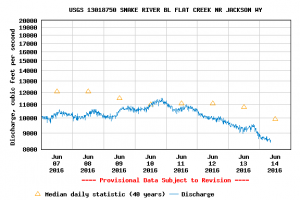
Snake River Flows below Jackson
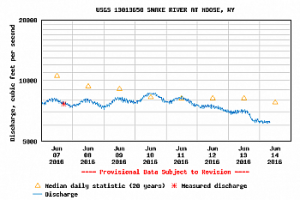
Snake River Flows at Moose Wyoming
Bureau of Reclamation info released today: “Jackson Lake inflow decreased by more than 1,500 cfs since last Thursday when the temperature was hot.
We reduced flow below the dam from 3,200 cfs to 2,800 cfs yesterday.
Today we will reduce flow to 2,600 cfs.”
The snowpack in the tribs that feed the Snake River in the north end of the valley are running out of steam so the next week will be telling once the temps heat back up.
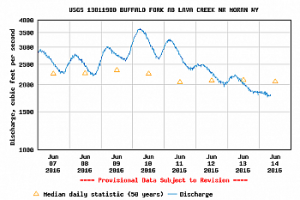
Buffalo Fork Flows
6.6.2016
Flows at Moose: 8230 CFS
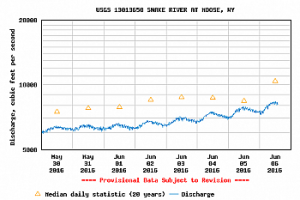
Snake River Flows
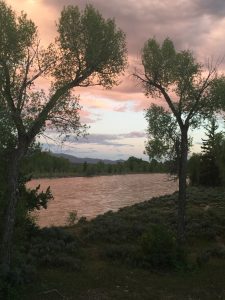
Snake
Flows below Jackson: 9899 CFS
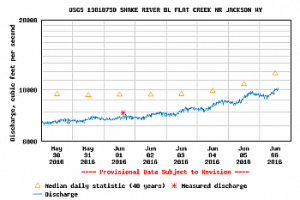
Snake River flows

Snake River
The Snake River in the Jackson Hole area has officially started run off stages. With a boost from the Bureau of Reclamation, the flows are now starting to get close to the 30 year average. The Pacific Creek drainage is running out of steam already due to the earlier heat waves and the Buffalo River is still running pretty close to average flows. We’re currently experiencing another heat wave, which is forecasted through the end of the week. At this point, given the Bureau of Reclamations plans to slow the flows down out of the Jackson Dam and the natural indicators, we’re thinking the Snake River should be fishable towards the end of June. Just in case it’s not, we still have several other options for quality fishing. Give us a shout to book your trip(s) @ 307-739-7020. We look forward to sharing the great waters of Western Wyoming.
5.23.2016
Flows at Moose: 3880 CFS
Flows below Jackson: 5710 CFS
So far, this season has been yet another challenging year to predict the runoff on the Snake River. As I was told from the Bureau of Reclamation last week; “it’s not drastically dry, it’s just drastically early.” With that being said, we’ve had much cooler temps lately, with a lot of rain/sleet/snow and hail. The temps have helped preserve the snowpack too, which is an added bonus. If the flows remain consistent with the prediction shown below, we are planning to start our guide operations on the Snake River around the last week of June. Barring any crazy rain storms, the flows look quite favorable for quality fishing throughout the summer and fall season on the Snake River.

Snake River Predicted Flows 5.23.16
Please give us a call to book your trip on the Snake River or to get the latest report @ 307-739-7020. Thank you and tight lines!
5.19.2016
Below is a piece on the current Snake River flows from the Upper Snake River Basin water manager, Mike Beus as published in the Jackson Hole Daily by Mike Koshmrl.
Based on this current plan Reel Deal is planning to start guiding on the Snake River around the 25th of June, if conditions are favorable to a quality fishing experience.
Jackson Lake releases to rise soon
POSTED: WEDNESDAY, MAY 18, 2016 4:30 AM
By Mike Koshmrl Jackson Hole Daily |
Snowmelt is flowing into Jackson Lake at a slow and steady rate and is on pace to reach the reservoir’s brims by the second week of June.
At that time Bureau of Reclamation managers figure they will “ramp up quickly” the dam release rate into the Snake River to 5,000 cubic feet of water per second.
“We’ll then start ratcheting down to 3,000 for the duration of the summer,” Upper Snake Basin water operations manager Mike Beus said Monday.
Beus and colleagues will present an in-depth forecast of their 2016 plans for Jackson Lake, which drive flows on the Snake, at a meeting to be held Thursday in Jackson. It’s happening at 6 p.m. at the Antler Inn conference room.
Although Jackson Hole had a near-normal snowpack this winter, raging rivers this spring are an unlikely result. “If it warms up quickly, our inflow will peak quickly,” Beus said. “If it doesn’t warm up, our peak inflow may have been last week,” Beus said. “Total volume is going to be 90 percent [of normal],” he said, “but we melted it so early and the remainder will be so strung out that we won’t really see any high flows.”
In Beus’ view the Snake is headed for a pretty typical rate of flow this summer. Average releases at the dam are “2,600 or 2800” cfs from July through mid-September — a bit below his forecast for 3,000 cfs. Jackson Lake, about 86 percent full early this week, is expected to reach its limits by about June 10. Downstream at the Idaho-Wyoming state line, Palisades Reservoir was at 79 percent of its capacity.
The snowpack in eastern Idaho melted off extraordinarily early, Beus said. But, he added, it’s been rainy enough that agriculture doesn’t figure to have much early season impact on the Snake’s flows in Jackson Hole. “It’s been relatively wet down here,” he said, “ and so irrigation demand came on rather slowly.”
Water from Jackson Lake is earmarked for irrigation in eastern Idaho. Needs of farmers and the rafting and fishing businesses closer to Jackson sometimes conflict about when and how much water should be released from the dam.
Contact Mike Koshmrl at 732-7067 or [email protected].
5.9.2016
Flows at Moose: 4790 CFS
Flows below Jackson: 6630 CFS
So far this spring and runoff season on the Snake River has been a roller coaster ride. We have snow predicted tonight which should slow down the melt for a few days. The snowpack is currently sitting at 66% which is pretty low for this time of the year. The rain we had over the weekend helped accelerate the melt, which is a double edged sword. But there’s not much you can do but sit back and see what happens.

Wyoming Snowpack 5/9/2016
Below shows the long range forecast for the Snake River which shows the flows not getting over 10, 000 cfs. If this prediction works out I would imagine the fishing will be happening in early July.

Runoff Prediction 5/9-9/6
Looking at the chart below you can see the two warm up periods we’ve seen so far causing approximately a 10% snowpack depletion for each spell. When the Bureau of Recalmation meets here in several weeks we will see what their plan is for the Jackson Dam operations
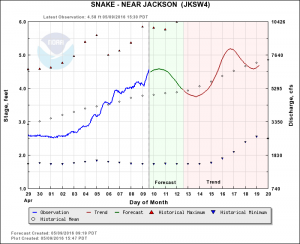
Snake River flows
Please give us a call to book trip or just to get the latest on the runoff conditions @ 307-739-7020.
Snake River Fishing Report
3.21.2016
Flows at Moose: 918 CFS
Flows below Jackson: 1330 Cfs
Water temps in the mid 40’s around 3pm
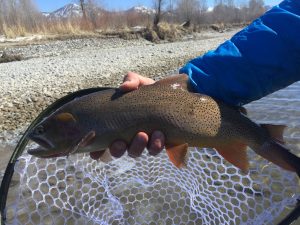
A Healthy Snake River Cutthroat
The Snake River has really turned on the over the past few days! We are now offering our float trips, which is the best way to enjoy the spring action. Our trips are from 10am to 5pm and are $450 which includes; rods/reels, waders, lunch, non-alcoholic beverages, flies and leaders. Excludes: Wyoming License and gratuity, if you feel so inclined.
The best action is in the afternoon, as the water temps warm up. We’re seeing midges, winter stones and a few bwos too. The larger fish are in the deep pools in the back water sipping the emergers. Be mindful of your false casting as these fish are super spooky. When nymphing, the best action is right below the riffles, at the drop off so you don’t need more leader length than the depth you’re fishing. We recommend using floro when fishing sub surface. For the dry fly set up 5x with 8-9ft is key. The dry dropper combo has been really consistent as well. After the bite on the surface slows down slowly stripping a streamer can produce a few fish as well.

One happy fella
The spring fishing conditions are really quite volatile and can change very quickly so we understand if it’s necessary to change dates or cancel. We have no cancellation policy and are very flexible. Case in point, I just looked up the weather report just now and here’s what it says:
JACKSON HOLE:
…WINTER WEATHER ADVISORY REMAINS IN EFFECT FROM 6 PM THIS
EVENING TO 6 AM MDT WEDNESDAY…
* TIMING…RAIN WILL MIX WITH SNOW EARLY THIS EVENING…WITH
PERIODS OF MODERATE TO OCCASIONALLY HEAVY SNOW. AN ISOLATED
THUNDERSTORM WILL NOT BE OUT OF THE QUESTION. SNOW WILL CONTINUE
AT TIMES THROUGH TUESDAY NIGHT.
* SNOWFALL AMOUNTS…3 TO 6 INCHES WITH 6 TO 8 INCHES QUITE
POSSIBLE IN THE NORTHERN STAR VALLEY.
* VISIBILITY…UNDER ONE HALF MILE AT TIMES.
* MAIN IMPACT…SLICK ROADS AND SHARPLY REDUCED VISIBILITY.
PRECAUTIONARY/PREPAREDNESS ACTIONS…
A WINTER WEATHER ADVISORY FOR SNOW MEANS THAT PERIODS OF SNOW
WILL CAUSE PRIMARILY TRAVEL DIFFICULTIES. BE PREPARED FOR SNOW
COVERED ROADS AND LIMITED VISIBILITIES…AND USE CAUTION WHILE
DRIVING.
3.8.2016
Flows at Moose: 918 CFS
Flows Below Jackson: 1330 CFS
Water temps in the mid 40’s
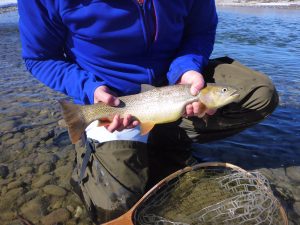
Snake River Cuttie 3/4/2016
The bite on the Snake River over the past several days has really been sporadic due to the fluctuating temps and cloud cover/sunshine. But, when its on, it’s really been on and when its off, well, it’s off. Typical late winter/spring conditions. Look for the midge bite to be good mid to late afternoon and the bwo’s have been popping too late afternoon on the cloudy days. The streamer bite is becoming more consistent too as we get closer to the spring cycles. Look for the action to be in the pools, seams, just below the riffles and back eddy’s, where the bigger fish are sipping ever so subtle.
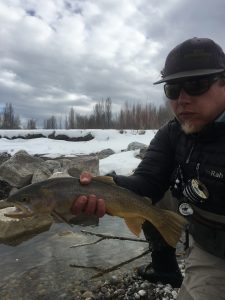
Josh
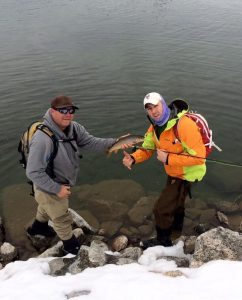
Teamwork!

Happy Client
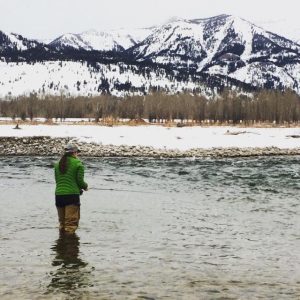
Solitude
Please call us @ 307-739-7020 to book your trips!

Tom’s on a roll!
2.16.2016
Flows at Moose: 946 CFS
Flows below Jackson: 1360 CFS
We’re seeing the air temperatures well above freezing these past few days, which is causing the valley floor snowpack to melt, therefore warming up the main stem of the Snake River. Late afternoon is when the water temps max out so the Midge bite has been best from mid day to late afternoon. The dry fly action has been spotty due to the high winds but there’s some pocket action where the bugs are sheltered and the bugs and fish have been just below the riffles and in the seam lines too. The regional forecast has a winter storm watch for late Wednesday through Thursday so we’ll see how that plays out. All in all, the bite has been getting better and much more consistent lately, but please keep in mind we’re still in the winter mode generally speaking.
We’re currently booking late winter trips and spring trips on the Snake River, Salt River and below Fontenelle Reservoir on the Green River. We’re also booking our summer season as well so give us a call at 307-739-7020.
Snake River Fishing Report
Based on this information below from the Bureau of Reclamation, starting Monday October 5th, RDA will be taking trips elsewhere until Monday, October 12th. This should give the fish sufficient time to settle into their new winter pools. We are currently booking trips through the end of October.
The planned schedule for flow changes on the Snake River below the dam follows:
Thursday, October 1, reduce flow to 1,500 cfs
Friday, October 2, reduce flow to 1,200 cfs
No change on Saturday or Sunday
Monday, October 5, reduce flow to 950 cfs
Tuesday, October 6, reduce flow to 700 cfs
Wednesday, October 7, reduce flow to 500 cfs
Thursday, October 8, reduce flow to 380 cfs
The flow until the initial change tomorrow is about 1,800 cfs. After reaching 380 cfs next week, no more changes are expected until next spring. Daily changes will be staged in two or more steps.
9.22.2015
Flows at Moose: 2710 CFS
Flows Below Jackson: 3370 CFS
It’s time to get out and enjoy the splendors of fall on the Snake River! These are the days we all hope and dream about and the weather is ideal and the forecast is solid for the next 5-6 days. After last weeks deluge the Snake River and all of the tributaries have all cleared up and are fishing very well! If you’re wanting to experience the Snake River in its prime, now is the time! The crowds have disappeared, the large trout are eating dries and the fall colors are nearing their peak as well! The dry fly bite has been after mid day continuing until mid to late afternoon. The trout are keyed in on the mahoganies, blue wings, a few pmd’s, caddis and believe it or not hoppers too.In the mid morning and late afternoon the streamer bite is getting rock solid too! Check out the river temps from the past week on the chart below. It’s been a wild type of season with both the surface and water temperatures fluctuating all over the place.
9.6.2015
Flows at Moose: 2617 CFS
Flows below Jackson: 3210 CFS
The Snake River got some color in it today from the rains that came through over the past day or so but is clearing up once again. Yesterday was cool, cloudy and windy in the morning but cleared up in the afternoon which produced a nice hatch of drakes and mahoganies. Last night the lows got into the high 20’s and will be near there again tonight. Check out the water temperature graph below.
We’re still seeing hecubas on the cooler and cloudier days and the fall stones are still around too. The fish are mostly keying in on the drakes and smaller mayflys currently when its cooler and the bite has been from mid to late morning to mid to late afternoon depending on the cloud cover. The side channels are producing some really nice sized fish as illustrated by the pic below from yesterday.
.
September is a great time to be out fishing on the Snake River and if you’re looking for a guided trip we still have a few slots left to get out with one of our professional guides. Please call us @ 307-739-7020 to reserve your trip today!
8.28. 2015
Flows at Moose: 2610 cfs
Flows below Jackson: 3120 cfs
The Snake River has been fishing very well with the bite being on hecubas and fall stones mostly the past few days.Thursday was rainy and overcast and the hecuba hatch was quite prolific and the fish were chowing them.
Friday there was overcast until mid day and the fall stones were the fly de jour.
The water temperature graph illustrates the changing temps below. Heck, it was almost 90 on Wednesday and Monday-Wednesday the morning temps hovered around freezing.
With the varying temperatures be ready to fish a variety of methods and places in the rivers. The dry fly bite has best been around mid day until mid to late afternoon, depending on the day. In the morning adding a dropper can increase your action as can fishing a streamer pattern. The tighter your fly is to the bank yields the better fish every time! The hecubas are mostly popping in the riffles, seams and pools along the foam line and the stones are near the banks, near structure.
Fall is soon approaching so get out and enjoy! We are booking into October so give us a call to reserve your trip today! Our reservation line is 307-739-7020. Take care!!!
8.19.2015
Flows at Moose: 2650 CFS
Flows below Jackson: 3130 CFS
The Snake River overall has been fishing consistently well and the flows have been very steady, just above 3,000 cfs for a while now on the lower end, and the fish are responding very well to the consistency. The milder temperatures as of late have helped water temperatures cool down and there is actually a little foliage that is starting to change colors in the high country and even around the river corridor in places. The graph below shows the varying water temperatures the over the past 19 days.
We’ve have seen that the cloudy / overcast / even rainy days have really benefited the fishing as those are the days when we’re seeing the most big fish. On the hotter / bright / sunny days the fish can be somewhat particular and expect to see some refusals here and there.
We have been trying to stick to fishing dry flies mainly, but that is not to say that fish will not eat nymphs. The dry flies that have been producing the most fish for us recently are : Fall stone imitations, (tan water walkers, etc) Dave’s Hopper, Yellow/Red Humpy, Chernobyl Ant, Green River Flying Ant, Cinnamon Ants , small beetle patterns, Mahoganies, Parachute Hare’s Ear, Parachute Adams, and a Parachute Pheasant Tail. Heck we’ve even seen a few hecubas as well.
When a nymph is needed we typically fish a Hopper/Dropper or Chubby/Dropper on slower moving banks and I like to fish a double nymph rig in the riffles, drop offs, and deeper holes. Pat’s Rubber Legs, Copper Johns, and Pheasant Tails have been very consistent.
The streamer bite has been getting better too and the patterns we have had the best luck are: Green Beldar Bugger, motos minnow, trash can, Galloups sex dungeons.
To book your fall fishing trip on the Snake River please call 307-739-7020 and get out there and have some fun!
8.10.2015
Flows at Moose: 2800 CFS
Flows below Jackson: 3510 CFS
This past week was a little bit of everything on the Snake River in terms of flies; we saw the bite most consistent on flying Ants, both cinnamon and black, but mostly cinnamon for the dry fly action. There are also fall stones out and about and the fish are definitely eating the big bugs! In the cooler morning putting a dropper on below the big bug has been quite productive as well. Swinging and stripping a streamer has been very productive as well throughout the day.
This past week was yet another wild week of weather and fluctuating temperatures both in the water and air. I’ve included this in the report as it is hugely important factor b/c the temperatures have a profound effect on the aquatic insect lifecycle, which affects the feeding pattern of the fish. For a deeper explanation on this please click on the link: http://sciencefairwater.com/physical-water-quality-parameters/water-temperature/water-temperature-ranges-in-rivers-and-streams/. The chart below shows the water temperatures from the past few days on the Snake River in Moose Wyoming. When the temps are consistent we find the hatches to be most consistent therefore the trout feed is too.
We have lots of great fishing options to share with you, so please give us a call to book your trip today! Our number is 307-739-7020. Thank you and enjoy your summer!
7.29.2015
Flows at Moose: 3110 CFS
Flows Below Jackson: 3750 CFS
The fishing conditions for the Snake River in Jackson Wyoming are sitting pretty for the rest of the season. All of the necessary ingredients are in place for stellar conditions. The Jackson Reservoir is currently at 87% (See chart below) full so not only do we have plenty of water for the remainder of the season we should have great winter flows too!
The wild fluctuations in our weather have definitely created some challenges but all in all the fishing/catching has remained consistent and productive. After this mornings low of 30 the August temps forecasted look to be average throughout the month of August, which will help the bite and hatches remain consistent. We are really fortunate to have such ample supply of water along with great temperatures, both water and air too.
We are looking forward to getting you and your family or friends out on the Snake River, so please give us a call to book your trip and get ready for an experience of a lifetime @ 307-739-7020.
7.22.2015
Flows at Moose: 3240 CFS
Flows below Jackson: 3860 CFS
The Snake River is getting better every day and we’re starting to see some of the larger fish starting to re-appear in the main stem now that the flows on the tributaries are ramping down. Getting your fly close to the structure and seam lines are producing the best yield. Caddis and pmd hatches are still the main focus and on the warmer afternoons the terrestrial bite is most prolific. The water temps are fluctuating between the mid 50’s in the morning to the mid 60’s in the afternoons and this is why the bite is best in the afternoons. When it’s really warm and sunny and the bite slows down during the afternoon, don’t hesitate to tie on a dropper on that hopper! We’re seeing some fall stone shucks on the rocks already, which is really early. It seems as though we’re setting up for an early fall and the fishing conditions will get even better!
7.1.2015
Flows at Moose WY: 4150 CFS
Flows below Jackson: 5080 CFS
The Snake River is getting into its prime now, especially in the morning hours. With the current heat spell, the fishing slows down in the afternoons aroud 1-2pm and picks back up in the twilight hours. There are zillions of yellow sallies, lots of pmds and caddis too and every day the quality of the action gets better and better. During the afternoon drop a bead head off of an attractor and you’ll be back into the action. As always the 4th of July weekend will be a zoo but keep in mind the early bird gets the fish!
6.15.2015
Flows at Moose: 7540 CFS
Flows below Jackson: 9380 CFS
The flows are dropping steadily on the Snake River with help from the decreasing flows at the Jackson Dam as well as the snowpack diminishing as well. (See explanation below)
“I hope that all of you were expecting us to reduce discharge today and this late notification doesn’t cause any problems. We have reduced discharge by 500 cfs to 3,000 cfs. The change was divided between 11:00 am and 1:00 pm.
Tomorrow, we will repeat a 500 cfs change to 2,500 cfs total flow below the dam. Changes will be made at the same times.”
Michael W. Beus Water Operations Manager, Upper Snake Field Office, Bureau of Reclamation
With these reduced flows and the decreased snowpack we’re anticipating improved fishing conditions on the Snake River over the next week. As they do we will update the report. We are now accepting reservations for our Snake River guided fishing trips on 6/24/2105. To book your trip please call 307.739.7020.
6.8.2015
Based on the news below concerning the flows from the Jackson Dam, we might be guiding on the Snake River in the very near future if the tribs will stop contributing off color water.
Jackson Lake inflow has been below 3,500 cfs since last Thursday, the Lake is down 10,000 acre feet (0.4 vertical feet) from its maximum on June 1, and it is time to reduce the discharge. We will reduce the discharge from 4,500 cfs in two steps at 3:00 pm and 4:00 pm today to 4,000 cfs. Tomorrow, we will reduce from 4,000 cfs to 3,500 cfs in two steps at 7:30 am and 11:00 am. Since Palisades is 94% full we no longer expect to need as much water from Jackson Lake to meet irrigation demand this season as was projected in early May. We will watch inflows for several more days before making additional changes.
6.5.2015
Flows at Moose Wy: 8670 CFS
Flows below Jackson: 11,500 CFS
The Snake River in Jackson Wyoming is now in full runoff mode and we’re not anticipating the water being suitable to good fishing for at least another several weeks. According to the latest from the Bureau of Reclamation the flows out of the Jackson Dam will be reduced much earlier than predicted due to the reduced irrigation demand in Idaho. The amount of precipitation the region has received is really impressive and we are all rejoicing considering the fact on how mild the past winter was! We’ll see how the snowmelt plays out from the Teton Wilderness and the Gros Ventre’s over the next week or so to get a more accurate assessment on when the Snake River fishing season will start here in Jackson Hole.
In the meantime we are offering guided trips on the Upper Green River where the fishing has been as good as ever! It’s a great way to see just exactly the opposite of crowds that you’ll experience in Yellowstone!
Please give us a call to book your trip of a lifetime @ 307.739.7020
5.21.2015
Flows at Moose: 3320 and rising
Flows below Jackson: 4590 and rising
Well we lost 30% of the snowpack in 3 weeks and now were seeing the rivers try and clear, for the moment. With the cooler temps lately and all of the rain its been a wild ride so far. Here’s whats happening now to the flows which will now make fishing/catching a reel challenge for awhile The Snake River in Jackson Wyoming is now experiencing runoff, again. this time it’s due to the new releases from the Jackson Dam. See the graph below.
Below is the explanation from the Bureau of Reclamation for the Snake River Jackson Wyoming:
“Cool weather has slowed inflow to Jackson Lake and we are still on track to fill before Tuesday, May 25. To delay the fill into next week we will increase discharge from 590 cfs to 1,800 cfs on Thursday, May 21. The changes will be staged in three increments at 3 hours intervals from 7:30 am to 1:30 pm with 4:00 pm reserved to make small corrections as necessary.
Once the Lake fills, inflow must be passed to avoid storing above Lake capacity. With snow depleted at all but the highest elevations inflow is not expected to exceed 4,000 cfs. Inflow should rebound as temperatures rise and if it reaches 4,000 cfs, we will not subsequently reduce flow below 4,000 cfs until late in June or later.”
What does this mean? Based on this information we’re not planning to be guiding on the Snake until late June or early July.
To book your trip for the summer season please call 307.739.7020
4.28.2105
Flows at Moose: 2540
Flows below Jackson: 3480
The Snake River is not as muddy as it’s been from the past week, but, with the forecasted high of 69 on Wednesday you can be assured it will be full on muddy and high once again. In the meantime, while the runoff does its thing, we have several quality options to fish for those who are around in May and want to get out.
Here’s our latest plan for May:
Full day trip to the spring creeks in Afton.: Leave JH at 8:30am and return late afternoon. The trip price is $450 plus $100 rod fee per person. Trip price includes rods/reels, waders, lunch, flies/leaders etc.
Half day wade trip to the Lower Flat Creek in the afternoons for $250. Trip price includes rods/reels, waders, lunch, flies/leaders etc.
Fontenelle: Full day trip meeting at the Daniel store at 7:30 am and returning by 6:30pm. Trip price is $575. Trip price includes rods/reels, waders, lunch, flies/leaders etc.
Any questions, comments or concerns please let me know @ 307.739.7020
Thank you!
Rhett
4.21.2105
Flows at Moose: 2000 CFS
Flows below Jackson: 2800 CFS
Water temps: lowers 40’s in the am to around 50 in the afternoon
The Snake River has gotten off color the past few days due to the warm spell we’re currently experiencing. The skwalla action was just getting started and the riffles were full of bwos ready to pop. Darn the luck. This is why its so difficult to predict spring fishing; the temps and snowpack change so dramatically year to year, its really a day to day situation. The river might get back into shape, hopefully, but not unless it cools off. Here’s a few pics from some action over the weekend.
Our summer season is booking up solid so please give us a call to reserve your slot today or just to check in as well. Our number is 307.739.7020. Thank you!
3.26.2105
Flows at Moose: 1210 CFS
Flows below Jackson: 1790 CFS
Water temps: mid to high 30s in the am to low 40’s in the afternoon
The Snake River in Jackson Hole has been pretty vacant the past few days due to the storms that have been passing through, which brought some really nice moisture. The Upper Snake snowpack has inched back up to 91%, which is great, considering the Upper Snake Reservoir System is 85% full right now! Starting Friday, look for the midge hatches to really start firing off again in the mid to late afternoons.We’re hoping for some more BWO’s to show up as well. Looking at the 10 day forecast, the temps look to be below freezing every night and only getting a few days in the low 50’s. With this forecast in mind look for the afternoon to be the best action overall.
Nymphing is still your best bet for consistent action but this weekend’s warmer temps we might get some dry fly action too. The fish are sure to be in the heads of the riffles, right where the depth drops off during the feed along with the inner foam lines too.
Our most consistent flies are:
Point fly: # 14-16 soft hackle pheasant tail or hare’s ear, copper john, black magic
Trailer fly: # 18-20 Allen’s mighty midge, zebra midge, drowning midge or a san juan worm in red or orange
Dry Flies: #18-20 Marvelous Midge emergers, high vis Griffith’s nat, spent midge, skittering midge or Bobs 5 second midge
Streamers: #4-8 white zonker, green weenies, white sex dungeon or a green beldar bugger
For our spring specials we’re offering a half day float for $375 from noon to 5pm or a 3/4 day for $450 from 10am to 5pm. To book your trip please call 307.739.7020.
3.18.15
Flows at Moose: 1230 CFS
Flows below Flat Creek: 1830 CFS
Water temps: high 30’s to low 40’s in the morning and high 40’s to low 50’s in the late afternoon.
Spring has sprung, in a huge way on the Snake River! March Madness is fully upon us in every sense of the phrase; Hoops, above average temps and killer fishing! The past few days have been absolutely fantastic action with short sleeve weather to boot. The midges and winter stones are still the flavor de jour, but don’t count the blue winged olives out either as they’re getting more prolific every day. The action has been best from 11am until mid to late afternoon. The fish are still in the typical spots along the seams and rip lines(where the currents meet) and foam lines as well. Look for the fish to be feeding in the middle areas of the pools in mid afternoon and towards the tail outs where the spent midges are. The dry fly action has been best in mid to late afternoon and the nymphing and streamer action have been good most of the day.
Our most consistent flies are:
Point fly: # 14-16 soft hackle pheasant tail or hare’s ear, copper john, black magic
Trailer fly: # 18-20 Allen’s mighty midge, zebra midge, drowning midge or a san juan worm in red or orange
Dry Flies: #18-20 Marvelous Midge emergers, high vis Griffith’s nat, spent midge or Bobs 5 second midge
Streamers: #4-8 white zonker, green weenies, flash a bugger or a green beldar bugger
Water Flows at Moose: 1000
Below Flat Creek: 1430
Temp range from 37 mid day to low 40’s late afternoon
Spring has started earlier this season and the fishing/catching on the Snake River is getting better every day. Yesterday there were a few pools with trout rising in the afternoon to sip midges and the winter black stones. With the warming trend forecasted over the next few weeks it should be really good and consistent. Heck, I’m thinking we will see Blue Winged Olives in the very near future!
The best action is in the mid to late afternoon and the fish are mostly still stacked up in the riffles and have been in the tailouts, seams and along the foam line. Nymphing is by far the most productive method with a 9 ft 4x set up with BB split shot about 8-10 inches above the point fly and the strike indicator about 6 inches below the leader connection.
Our most consistent flies are:
Point fly: # 14-16 soft hackle pheasant tail or hare’s ear, copper john, black magic
Trailer fly: # 18-20 Allen’s mighty midge, zebra midge, drowning midge or a san juan worm in red or orange
Dry Flies: #18-20 Marvelous Midge emergers, high vis Griffith’s nat or Bobs 5 second midge
Streamers: #4-8 white zonker, green weenies, flash a bugger
We’re currently offering wade trips and will start our float trips on March 16th.
Wyoming Snow and Water Forecasts and Winter Predictions
11.17.14
Trying to predict the current winter snowfall and next season’s water supply is a very tricky and unpredictable process. Conditions are ever changing, especially in the mountains. We rely on a plethora of scientific data that’s available to us via the internet such as these websites:
http://www.noaanews.noaa.gov/stories2014/20141016_winteroutlook.html
http://www.wrds.uwyo.edu/wrds/nrcs/snowmap/snowmap.html
http://www.nwrfc.noaa.gov/rfc/
http://www.usbr.gov/pn/hydromet/burtea.html
http://waterwatch.usgs.gov/?m=real&r=wy&w=map
These sites have an amazing amount of useful data but it often comes down to late spring time before we really have abetter idea of which drainages will be fishing at which time and their prospective flows. Noting that this past August was cold and rainy, which was really odd for the high desert we call home. It is worth noting that after this past year’s moisture collectively Wyoming is doing very well on holdover water for next season. We encourage you to look at them and try to get their basic relevance.
This map from NOAA shows a 50/50% chance of snow for our region. Not bad, I guess………kinda like all things in life to me.
9.27.14
Starting Monday the Bureau of Reclamation will begin to reduce the flows out of the Jackson Lake Dam on the Snake River, which will begin to effect the quality of the fishing mid week. With the majority of the flow reduction taking place this upcoming week we’re anticipating the week starting 10/5 being better fishing as the fish get re-settled.
8.19.14
Snake River Fishing Report Jackson WY
Flows at Moose: 3260 CFS
Below Jackson: 3770 CFS
The flows have settled down once again for the Dam release being cut down another 500 cfs. The lower the average flows, water temps and cooler and cloudier weather are setting the Snake up for an EPIC fall season. The fish are eating the Claasenia Stonefly and is the hot ticket and any type of foam with tan and brown size 6-10 has been productive. The fish are tight to the banks, behind structure and in the deep seams below the gravel bars where the braids meet. With the water temps in the high 50’s in the early morning try a streamer pattern in the riffles, banks and seams. There are also caddis out in the evenings.
Claasenia Stonefly Nymph
Look for the Hecuba to emerge in the next week or so with these cooler temps.
Come on out and enjoy the splendors of these fall like temps and the dissipated crowds!
Snake River Fishing Report Jackson Hole Wyoming
8.13.14
Flows at Moose: 3950 CFS
Flows Below Jackson: 4550 CFS
After last week’s huge week of moisture the Snake River Fishing Report Jackson Hole Wyoming is settling back down and fishing very well. There are still plenty of PMD’s in the riffles and now that the flows are receding we’re seeing more fish spreading out along the banks. There have been plenty of hoppers out and the fish are looking at hopper and larger foam patterns and other terrestrial patterns such as ants and beetles too. We’re also seeing more and more of the bigger fish coming back into the main stem of the Snake from the tributaries. As we start to see cooler temps expect to see the Snake Drake along with the Fall Stone and the Hecuba too. On the warmer afternoons adding a dropper below an attractor pattern is sure to create more opportunity. As long as these flows continue to be consistent then we’re setting up to have an epic fall here in Jackson Hole on the Snake River.
Snake River Fly Fishing Report
8.1.14
Flows at Moose: 4410n CFS
Below Jackson: 5000 CFS
The Snake River Fly Fishing Report is the fishing good now with the fish looking at PMD’s, Yellow sallies and an assortment of foam patterns. A dropper off of the foam has been producing action as well. The faster banks are not holding many, if any fish and the slower banks and riffles have seen the best opportunity to see action. The best action has been mid morning until mid afternoon. The fishing conditions should remain consistent as long as the flows from the Jackson Dam remain constant throughout the rest of the season and the bigger fish should start appearing more frequently as the tributary flows start to drop. It is important to know that most of the flows on the regions waters have been above average fro the month of July and are just starting to come down to average flows. We still have a few slots available for the month of August so please give us a call @ 307.739.7020 to book your professionally guided fishing trip.
7.20.14
Snake River Jackson Hole Fly Fishing Report
Flows at Moose: 5500 CFS
Flows below Jackson: 6500 CFS
The Snake River in and around Jackson Hole is getting closer to being a quality fishing experience. RDA has chosen to wait until the quality of the fishing/catching experience has reached it’s potential and we feel that the time has come so we’re sending our first scout trip out tomorrow. As we predicted several months ago that we’d be guiding on the Snake River towards late July. There have been quite a few guided trips out there for the past 6 weeks but we have chosen to take our valuable and respected clients elsewhere. We’re looking forward to getting our clients and their families out for a wonderful experience. To book your trip please call 307.739.7020.
Snake River Fly Fishing Report
So far this runoff period has been extraordinary unpredictable, BUT the flows released from the Jackson Dam now seem to favor optimal flows for great fishing! Please read the story below from the JH News and Guide today.
“Snake releases a surprise”
“Water managers responding to an unpredictably steady rate of snowmelt have scrapped earlier plans and now expect to hold releases into the Snake River steady at relatively low levels through the summer.
Going into runoff season, Jackson Lake Dam outflows were predicted to top out at a flushing flow of nearly 6,000 cubic feet per second in late June and then to taper off to a summer release rate of about 2,500 cfs.
Instead dam outflow never even broke 2,000 cfs and now looks likely to stay below that volume into the fall, the Bureau of Reclamation’s Mike Beus said Friday.
“We’re on a completely different path than we anticipated,” said Beus, the bureau’s Upper Snake Basin’s water operations manager. “The snowmelt just went away.”
The latest models show that Jackson Lake Dam releases, 1,848 cfs on Thursday, will stay steady “approximately through next week,” Beus said.
“We stepped up to this level the last day of May or so,” he said, “and have been there ever since.”
Over the years average dam releases for June 28 are about 3,500 cfs.
Although Jackson Lake is 97 percent full, Beus anticipated being able to maintain the relatively low rate of release into September.
The water situation downstream at Palisades Reservoir is even more of a shocker.
“We were expecting 100 percent [full] and having a little bit of high flow,” Beus said. “We were planning to be in the mode of preserving space.”
Instead, he said, Palisades is 72 percent full and slowly creeping back down.
While the lighter-than-expected runoff isn’t ideal for filling reservoirs or recreational floats, the steadiness is generally welcomed by fishermen.
While Beus didn’t expect any major changes to Snake releases anytime soon, he emphasized it’s impossible to predict what will happen
“Forecasting our inflow is the next step past predicting the weather.””
Posted: Saturday, June 28, 2014 4:30 am
By Mike Koshmrl Jackson Hole Daily
6.23.14 Snake River Fly Fishing Report
Flows below Jackson: 7620
I can’t believe that i’m even writing the contents of this report today but the Snake is somewhat trying to clear up enough to get in some reasonable fishing and there’s been a few reports of the fishing getting better every day. The spin fishing has been good, sub surface is ok too and the dry fly is seeing smaller trout coming up. Most of the action is near the spring creeks that flow into the main stem of the river and near the confluence of lower Flat Creek too.
The Bureau of Reclamation will start increasing flows out of the Jackson Dam soon which is sure to stir things up once again. that being said here’s the NOAA prediction:
As you can see the by the chart that the initial prediction was WAY OFF so we’ll just have to wait and see if this warming trend brings more snowpack down.
5.29.14
Snake River Fly Fishing Report
Flows at Moose: 10,100 CFS. Below Jackson: 15,300
The Snake River Fly Fishing Report is: MUDDY AND HUGE! The dam releases are just now kicking in and will make the flows even higher. The snow moisture still left in the mountains are still 143% of a 30 year average as of today. See the prediction chart below from NOAA.
It’s going to be awhile until the Snake River settles down and is fishable; as of now we’re planning on late July before we start guiding trips on the Snake River.
5.22.14 Jackson Hole Fishing Report Snake River
Flows at Moose: 6260 CFS
Flows Below Jackson: 7490
Based on the current runoff and dam operation plan (see below) for the Jackson Lake dam the flows will be very high and not be fishable until the latter part of July given the current scenario. We will continue to update as the conditions become more favorable for fishing.
The photo below was taken yesterday above the South Park Bridge.
If you right click on this link you will see a short video of the Snake river from yesterday as well. IMG_3528
5.7.14
Flows below Jackson: 4450 CFS
The current Snake River Fishing Report is that the rivers are now completely blown and they will be for the next few months due to the HUGE snowpack still up high in the mountains. As of yesterday the total snowpack is 144% of a 30 year average, which compares to a lot of water, thankfully. We will continue to update the report as the conditions become favorable for fishing and at this time we’re taking bookings for late July until the end of the season. Typically after a huge ‘flush’ on the rivers the hatches can be quite prolific! 4
Last week we were able to get one day in on the skwalla and caddis hatch which was fantastic, unlike last year’s hatch which lasted on and off for several weeks.
At this time we’re taking bookings for late July until the end of the season on the Snake River. RDA will be guiding on the Green, New Fork River and Salt Rivers starting in late June we think, given the current predictions.
4.25.14
Flows at Moose: 1650 CFS
Flows below Jackson: 2840 CFS
The latest Snake River Fishing Report from our local Jackson Hole Fly Fishing Guides this week is the river has cleared up from earlier this week due to yet another cold spell. The water temps have dropped and so have the flows. We’re catching fish on weighted nymph rigs consisting of either stones as the point fly and either a bwo or a small stone dropped below the stone. Yesterday we had intermittent snow flurries and the next few days the forecast is pretty much the same. See today’s weather below;
-
SPECIAL WEATHER STATEMENT
Now – Friday, Apr 25, 8:15am
THROUGH THE MORNING COMMUTE…TETON PASS WILL BE SLICK AND HAZARDOUS WITH FOG AND PERIODS OF SNOW. IN THE LOWER ELEVATIONS…PRECIPITATION WILL BE A MIX OF RAIN AND SNOW…WITH RAIN GENERALLY BELOW 6400 FEET. A COUPLE OF INCHES OF NEW SNOW COULD OCCUR ABOVE 8500 FEET THIS MORNING.
For the foreseeable future we’re expecting these same weather patterns persisting so the fishing conditions on the Snake will be hit and miss on a daily basis. That being said we’re hoping to get a chance to get a few days out on the skwalla hatch. The water temps need to stay consistent in the upper 40’s to make this happen. That, along with some clear water and I must say this hatch is as good as it gets for big fish on big dries. Please give us a call @ 307.739.7020 for the most up to date report.
Below you can see the temps and water graphs for this week.
4.16.14
Flows at Moose: 904 CFS (Temp Range 37-42)
The Snake River has cleared up and the nymph fishing has been very good the past few days on stonefly and midge patterns. The water temps are still cold but we expect them to increase as the week end comes around. The flows have come down significantly(see chart below) the past few days so we’re looking for the blanket midge and blue wing hatches to return very soon. We’re still out guiding so come out and enjoy the Snake River without the crowds and crazy high flows! Call 307.739.7020 to book your trip or make an inquiry. We’re booking for the 2104 summer season!
4.12.14
Flows at Moose: 1000 (CFS temperature range from 38-48)
Our Jackson Hole Fly Fishing Guides report that the Snake River has gotten off color the past few days with the heat spell we’re experiencing currently. Prior to that the Midges have been plentiful and there’s been a few Blue Winged Olives out as well. We found fish feeding on the surface eating both where the clear water was coming into the main channel in the afternoon. We’ve had several boats out the past few days and you’ve had to earn every single fish! Given the current long range forecast the runoff should fluctuate so check back often or give us a call @ 307.739.7020. We’ll have boats out on the Snake as soon as it clears up, hopefully by Tuesday. We’re now booking for the 2014 summer season so give us a holler to reserve your slot.
3.15.14
Flows at Moose: 714 CFS
Flows below Flat Creek: 1240 CFS
The Snake River Fishing Report this past week has been great action in the afternoons from around 1-4pm give or take a few. We’ve had great action on dry, wet and streamer patterns. Each day has been a bit different depending on temps (water and air). cloud cover and wind. Over all the action has been consistently good and the fish all look very healthy as evidenced in these pictures and are feisty. The dry fly action has been great using a parachute adams, Bobbs 5 second midge and/or a high vis Gnat using 5x tippet. The nymphing has been incredible using a flashback pheasant tail (#14) and a zebra midge or wd-40 (#18) combo. W’ve been using a 9′ 4x leader tied to the point fly and 5x tippet on the trailer fly. Depending on the depth and speed of the water you should adjust your weight and indicator accordingly. With the upcoming forecasted temps we’re looking forward to some includible spring fishing conditions! The Snake River fishes at its prime during Spring and Fall before the Idaho irrigation seasons and runoff, which we’re anticipating to be huge with our current snowpack.
3.3.14
Flows below Flat Creek: 1160 CFS
The latest Jackson Hole Snake River Fly Fishing Report is get out on the water! Now that we’ve seen about 12 feet of snow in February our water conditions have improved significantly. The temperatures this past week have been on a warming trend which have made the mid day midge hatch come alive. The best action is still from around 1-3pm. We had our first guided trip on Saturday and the bite was on. The valley floor is starting to melt with all of the warm temps and rain and the fish are getting quite active. There has even been fish caught on streamer patterns. Our hottest nymph patterns are the flashback pheasant tail nymph, the allen brothers magic midge and the infamous san juan worm in either a light brown or red color. The cone head green machine streamer has been the ticket on a 9′ 3x leader. The dry fly that we’re seeing the best results are on Bobbs 5 second midge and a high vis gnat.
2.12.14
The current Jackson Hole Fly Fishing Report for the Snake River this week is; the fishing has been productive in the afternoons now that we’ve had so many warm days and nights in a row. The water temps have risen a few degrees and the overcast days mixed with moisture have made the midge hatches quite prolific. The fish have been stacked in the head of the riffles and the back of the pools, with many fish suspended midway in the water column. Nymphing is still the go to setup for productivity but there’s been some fish up eating the emergers as well. Give us a call so we can get you out this winter for an amazing afternoon.
The graph below shows just how low the water supply is in the Upper Snake River but we’re getting pounded with great snow currently. The reservoirs are at 42% of capacity and our snowpack is 112% of average, so all in all we’re definitely headed in the right direction for another stellar season!

2.4.14
This week’s Jackson Hole Fishing Report is; it’s going to brutal for getting out on the water. With the frigid temps and wind chill i’d suggest getting out on the your skis or snowmachine and stay bundled up! Friends who were fishing over on the Bighorn yesterday nearly froze to death. Even with heaters! OR get your work done so when spring comes you can get out without a guilty conscience. Our snowpack is continuing to hover around 100% so we’re hoping and praying to stay there or grow until runoff starts! The month of February has a lot of snow forecasted so far! We’re looking forward to another great fishing season so please get in touch while we still have slots available.
1.19.2014
Here’s this weeks Snake River Fishing Report in Jackson Hole Wyoming;
With the wild swing of temperatures we’ve been experiencing this past week the fishing on the warmer afternoons has been fairly consistent. That being said, with the warmer temps we’ve had some crazy winds this past week but hopefully we’re going to get a reprieve for awhile. The name of the game is still midging, mostly on nymphs. The action has been limited to a several hour window in the afternoons from approx. 2-4pm when the temps are above 25 degrees. Your best bet is to nymph a 7-9 foot 5x floro leader with a flashback pheasant tail (#16) as your point fly and drop a small zebra midge (#20) about 18″ below the point fly. Make sure you add some split shot above the point fly which the weight amount will depend on the depth and speed of the water you’re fishing. Bobb’s 5 second midge #22 for the dry is very effective if you can see it on the water. If you’re having trouble seeing it tie on a point fly, we suggest a high vis g nat #20 with 5x tippet.The fish seem to be concentrated either in or near the riffles, with some feeding either in the back of the pool or slightly suspended below the surface.
10.18.13
The Snake River is and has been fishing AMAZING every day! The October caddis seem to be fizzling out but the BWOS are as thick and plentiful as they can be. Look for the fish in the back of the pools, near the seams and in the riffles. With the warm temps forecasted for the next week we’ll still be guiding every afternoon from our private access. The afternoon Fall Special on the Snake is $350 per boat, which includes all gear necessary. Give us a shout at 739.7020 to book your trip.
Flows at Moose, WY: 1060 CFS
9.29.13
The Bureau of Reclamation will be reducing the Jackson Lake Dam starting tomorrow, which will definitely throw off the fishing for the next several weeks on the Snake River.
Flows will be reduced beginning Monday, September 30th and lows will drop from approximately 2700 cfs to 1200 cfs between Monday, September 30 and Friday, October 5. Flows will remain steady over the weekend. Reductions will resume Monday, October 7th and reach winter flow of 280 cfs on Friday, October 11th.
The fishing around the area rivers has been simply amazing and we’re now offering fall specials so please get in touch with us for some excellent fall fishing.
Since we’ve received so much precipitation in the past few weeks we are still guiding float trips on the following rivers:
http://www.reeldealanglers.com/our-rivers/green-river/
http://www.reeldealanglers.com/our-rivers/new-fork-fishing/
http://www.reeldealanglers.com/our-rivers/salt-river-fishing/
http://www.reeldealanglers.com/our-rivers/fish-creek/
http://www.reeldealanglers.com/our-rivers/flat-creek-fishing/
http://www.reeldealanglers.com/our-rivers/red-rock-ranch-fishing/
9.11.13
Flows at Moose: 4560 CFS
Now that the muddy water has passed through the Snake River our fishing/catching has picked up once again. With the cooler temps in the mornings the Hecuba hatch has been starting around 10-11am the past few days. Look for the Fall stones, mahoganies, bwos and caddis throughout the day and evening.
9.3.13
Flows at Moose: 4400 CFS
With the amazing amount of moisture we received yesterday the PMD’s are out on the Snake River by the zillions! These along with the Hecubas make this as good of dry fly fishing as the Snake gets, EVER! With the cooler mornings the action has been getting good around 10 am and lasting till late afternoon. The fall stones are still abundant as well, especially in the afternoons. If you want the best of the best try our private spring creek in the morning and float the Snake from our private access in the afternoon!
8.25.13
Flows at Moose: 4710 cfs
We’re VERY happy to report that we’ve received a significant amount of rain the past few days and nights which has cooled the waters on the Snake River and surrounding tributaries. The fish are really keying in on the Hecubas and the classinia stoneflys! These hatches are amongst the most prolific hatches of the entire year. The big fish really key in on them and it’s not uncommon to pull up to a riffle and and see 6-8 16″-20″ fish feeding in on them. The Hecubas are found mostly in the riffles and the stoneflys are at the tail outs and along the banks.
Our private access to the Snake provides a pristine environment to see lots of big fish, very few people and boats along with lots of wildlife! We welcome you to join us for a wonderful day of angling and if you want to complement your experience please consider a trip on Fish Creek as well.
8.18.13
Hoppers. Droppers, Ants and Stones are the flys de jour currently.
The most recent Snake River Fishing Report is that currently, we’re on the upswing(again) with some very warm temperatures in the afternoons(see chart above). With that being said, the trick is to be the early bird on the water and fish hard till mid afternoon, until the water temps get too warm. Then we recommend cracking a cold one open and enjoying the rest of your day! As the temps increase the size of the fish decrease. The larger fish start to shut down around 66 degrees F and the smaller fish can still manage until approx 70 F.
The better news is; the flows from the Jackson dam are decreasing very gradually which is keeping the fish consistently in their current habitat and this should continue for the foreseeable future, we hope.
About mid week the temps are forecasted to decrease so this should make the fishing last longer throughout the day. We’ve had trips out this past week all over and we’re seeing the Cottonwood and Aspsen trees already start to change colors. The fall stone fly has been appearing and we’re thinking as the temps start to decrease the hecuba hatch will start as well.
8.11.13
Flows at Moose: 5060 CFS
The past several days of heavy cloud cover in the morning has kept the water temps lower throughout the day so the fishing/catching has been very good the past fews days all day long. Terrestrial time is in full effect on the Snake River in Jackson Hole and will continue for the next few weeks until the hecubas and classina(stoneflys) start to appear.Also, we been having a reasonable amount of success using the crane fly pattern as well. Some of the larger fish are settling in on the banks taking advantage of the terrestrial bite. We invite you to come see what our private ramp access to the Snake River is all about; fishing without all of the crowds is priceless, especially in August!
8.5.13
Flows at Moose: 5320 CFS
The Snake River has been fishing better and better every day! Thankfully, the Bureau of Reclamation slowed the Jackson Dam release down by 500 cfs several days ago and will be doing it again, hopefully soon. This combined with the cooler temps from the rains last week have provided some incredible dry fly action. We’re seeing LOTS of PMD’S still and before and after the hatch the fish are looking for the terrestrials on the banks, in the pockets and riffles as well. With the sun out for the better part of the day we’re seeing the best action from 8am till mid afternoon, then again in the evenings after the sun starts to get lower on the horizon.
7.27.13
Flows at Moose: 5850 CFS
The Snake River in Jackson Hole Wyoming has really turned on the past few days. We’re seeing lots of nice fish eating large terrestrials and some fish over 20″ smashing the streamers. Hopefully, the scorching temps have subsided for the season and we can “get down to business.” With August being the busiest month out of the entire season we welcome you and invite everyone to come check out our private access to the Snake River in Jackson Hole Wyoming. We are sure you will appreciate the serenity and surroundings void of the masses.
7.21.13
Flows at Moose, WY: 6030 CFS
The Snake River in Jackson Hole has cleared up as we anticipated, thankfully. The name of the game this week is EARLY BIRD GETS THE WORM!!! The water temps are nearing 68/9 degrees in late afternoon which shuts the fish off with their survival instincts. We’re seeing good action from 7:30am to approx. noon due to the rising water temps. Hopefully, with cooler temps on the near horizon the fishing days will elongate once again. The natural cycle has been 30 days early this year so we’re hoping for a cooler August.
7.19.13
Flows at Moose: 6230 CFS
As of this morning the Snake River blew out due to a huge storm that followed the Buffalo River Valley night before last. Up until today the dry fly fishing was getting better every day. We’re hoping the Snake River will settle in clear over the next few days. The problem with the dirty water directly relates to the fire last year up in the Teton Wilderness. The fire was started by campers who failed to extinguish their campfire, so now we’re left with the repercussions. Check back in the next few days as we will continue to monitor the quality of the water.
We will continue to have higher than normal flows this season but these high flows have made great new side channels that are chalk full of fish in the riffles and are chowing on PMDS.
The excerpt is from the Bureau of Reclamation’s meeting on 7.17.13 regarding our current flows.
Releases from the dam are currently just below 5,000 cfs. No change in outflow is anticipated before August 1.
Jackson Lake is currently 75% capacity and falling 0.3 ft per day. Colter Bay boat ramp should be functional until about August 1. Signal and Leeks boat ramps should be functional through September. Due to recent increases in inflow to Jackson Lake, projected storage at the end of the season is now 150,000 acre ft.
BOR will update operations again 9:00 July 31. They are currently anticipating flow reductions after August 1 by 500 cfs every 2 weeks.
7.10.13
Flows at Moose: 6300 cfs
The most current fishing report from the Snake River is were FINALLY seeing some clearing and settling down, which RDA plans to get out on guided trips starting in the next several days. The flows out of the Jackson Dam will remain constant at 5000 cfs through the month of July and the exact flow on the Snake River is still not known for the rest of the season. The tributaires are dwindling down after all of the rain we had over the past week, which we needed and rejoiced about! The pmds are still out and with the warmer temps this week we’re anticipating the terrestrial season to kick off. The fish are still in the side channels or any place there’s a place for them to get out of the main channel, which is moving very fast. You’re best best is to get out of the boat and find some clamer water near a riffle, overhanging willow or log structures.
6.21.13
Flows at Moose WY: 7345 CFS
The Snake River currently is running higher than last week due to the increased releases from the Jackson Dam the past several days. We’re anticipating the higher flows for the next few weeks, which will make fishing a challenge. BUT, there’s still fish to be found in the side channels and where the tributaires flow into the Snake. There are Golden Stones EVERYWHERE and if the water is slow enough, fish are eating on the surface. With the cooler temperatures the past several days the tributaries are clearing up which should help improver the clarit in the main stem of the Snake.
If you’re looking for a quality fishing experience in the Jackson Hole area you should give our private spring creek a go. The Pmd and Green Drake hatches are blowing up and we’re seeing record numbers of trophy trout fighting over the bugs!
GIVE US A HOLLER TO BOOK YOUR TRIP @ 307.739.7020
******UPDATE: AS OF 6.8.13 THE SNAKE RIVER IS NOW BLOWN OUT********
Reel Deal has great waters to fish so please call us @ 307.739.7020
Currently the Snake River is somewhat clear but still needs some settling down to be considered fishable. With that being said, we had several guides scout it yesterday and they did manage to farm up a few on dry flies. With the warmer temps forcasted for the weekend, be prepared for higher and muddier water. At this time RDA is plannning to guide the Snake is several weeks; or as soon as it meets our standards. The tributaries still have snow above 9000 ft so we’ll see what happens over the next week or so.
In the meantime, Fish Creek, our private spring creek is turning on and we’re getting ready for the Green Drake hatch! This hatch is an AMAZING experience and LOTS of big fish are starting to populate the creek.
Flows: Moose 5510 CFS Fish Creek: 400 CFS
For more information please click the link or call us at 307.739.7020.

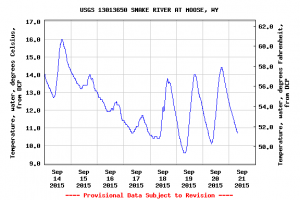
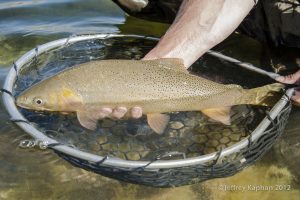
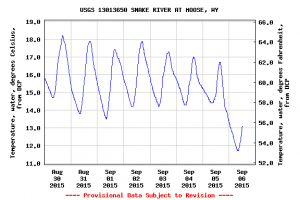



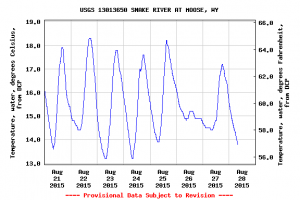
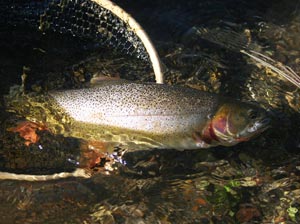
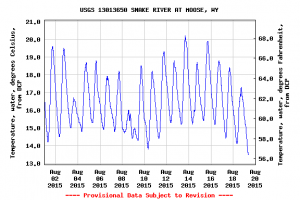

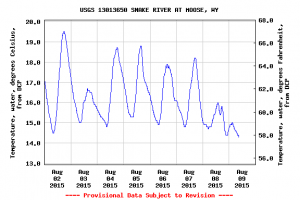

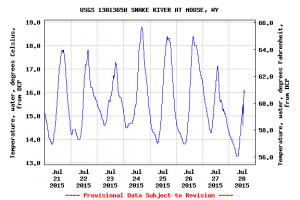

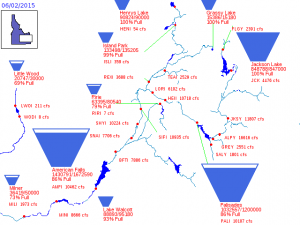
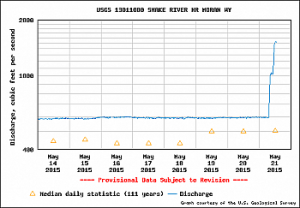

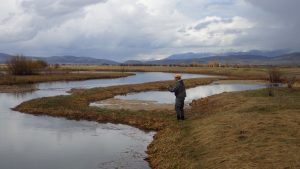
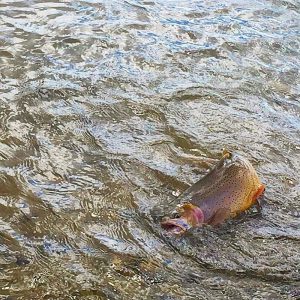





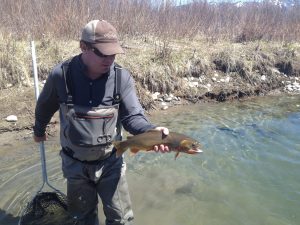
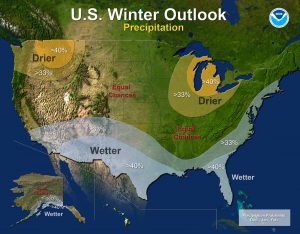

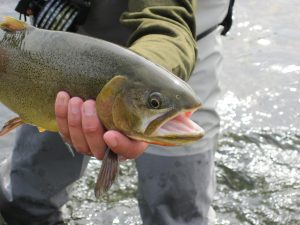


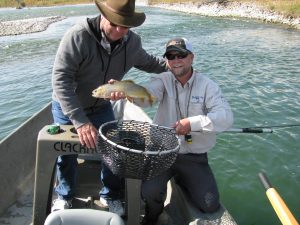
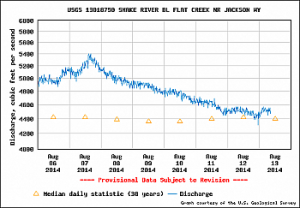
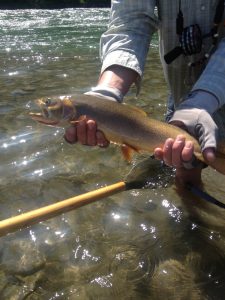


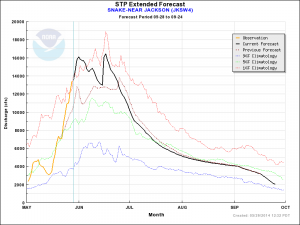
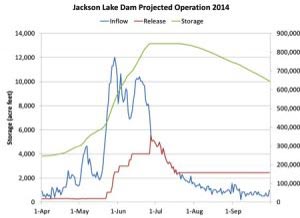
![photo[2]](https://www.reeldealanglers.com/wp-content/uploads/2014/05/photo2-225x300.jpg)
![photo 1[1]](https://www.reeldealanglers.com/wp-content/uploads/2014/05/photo-11-300x225.jpg)
